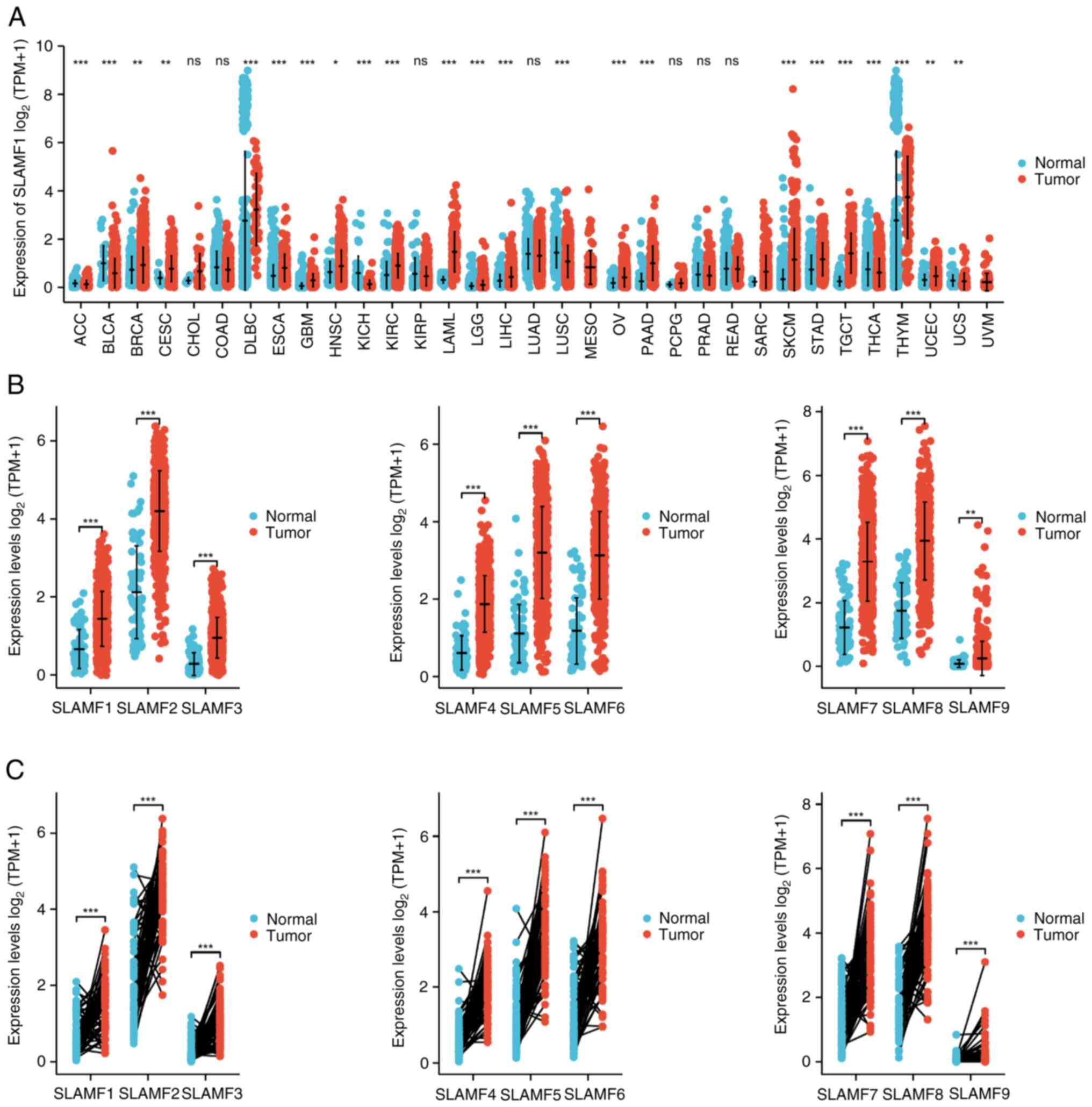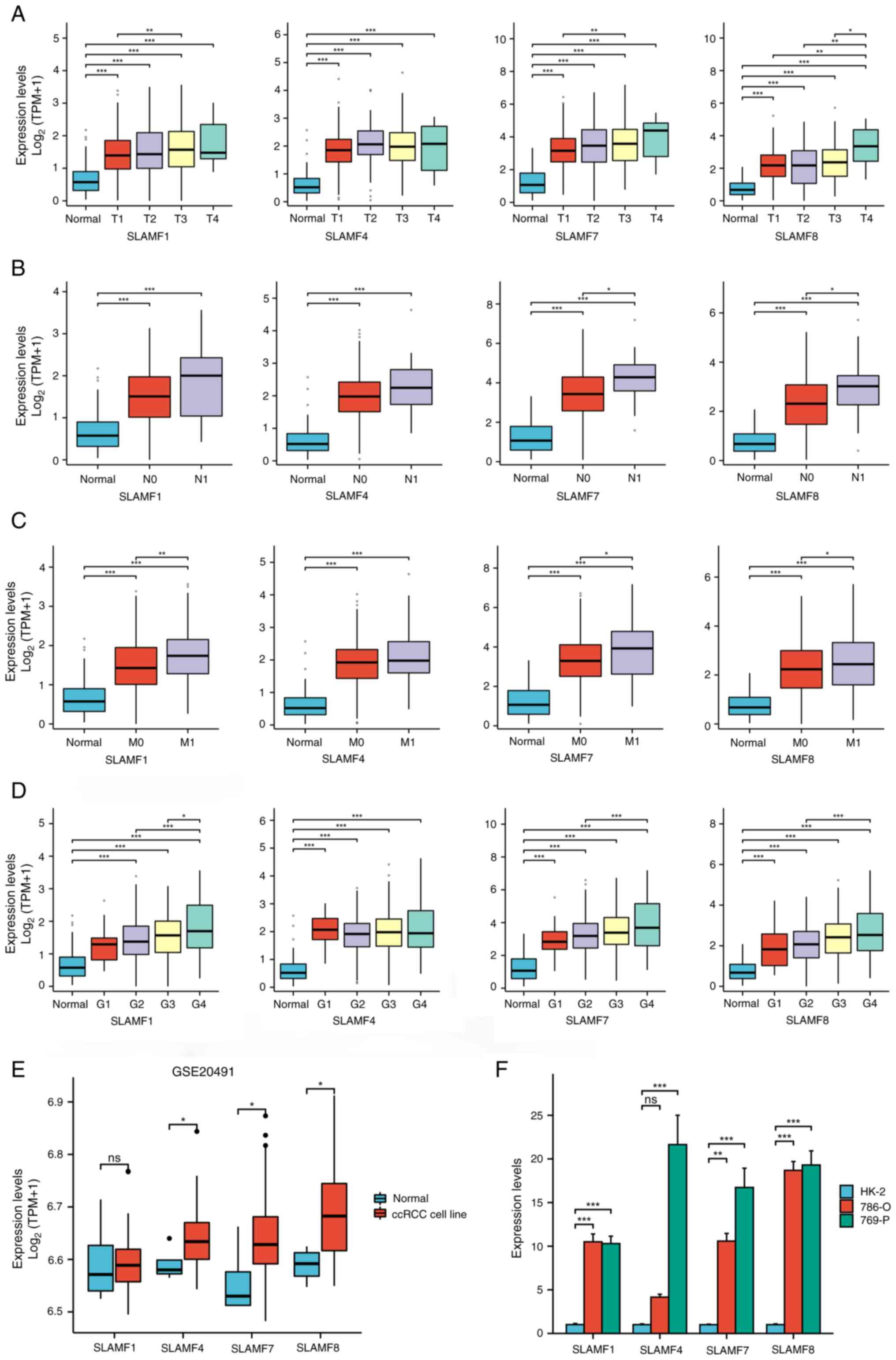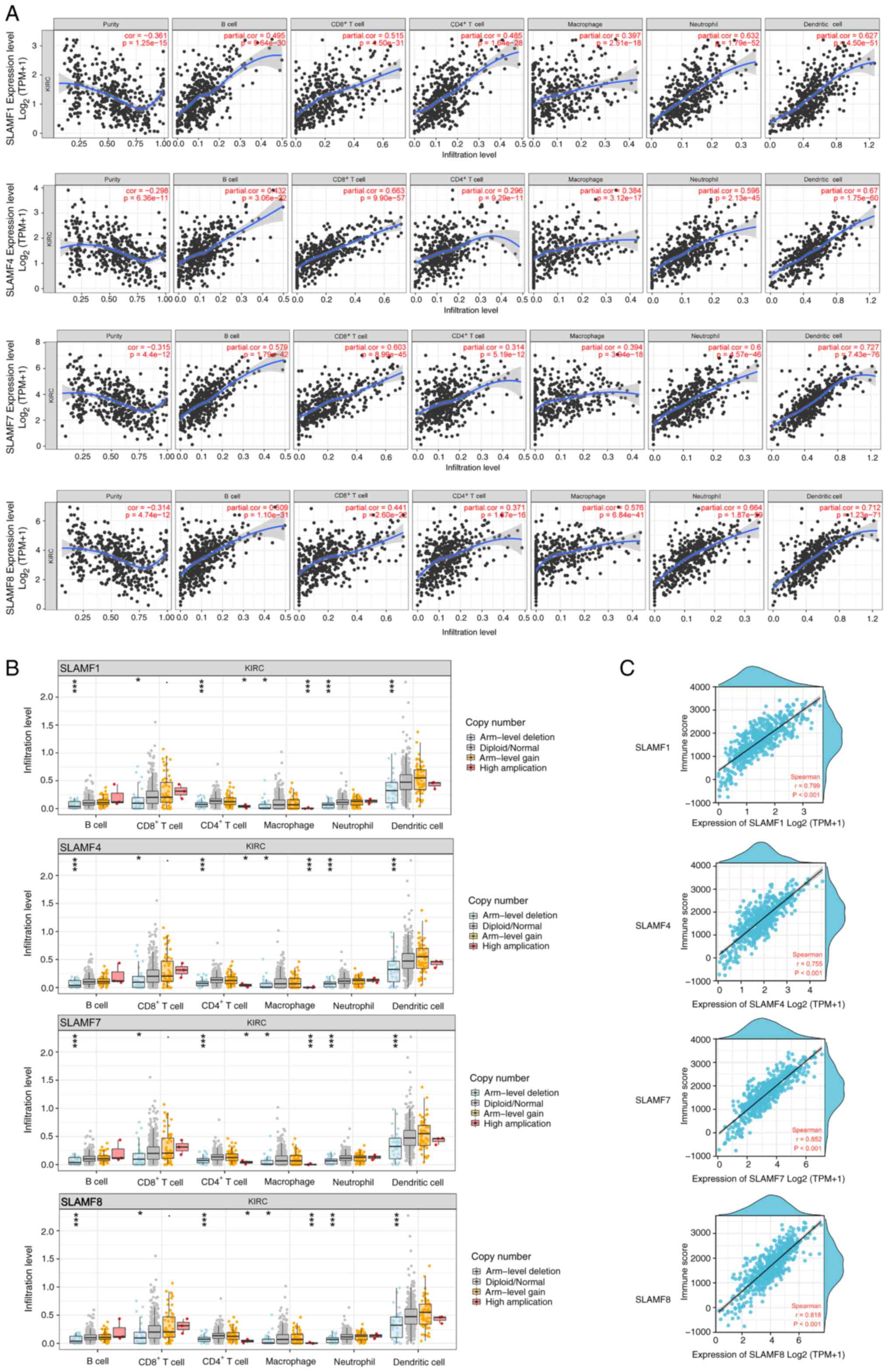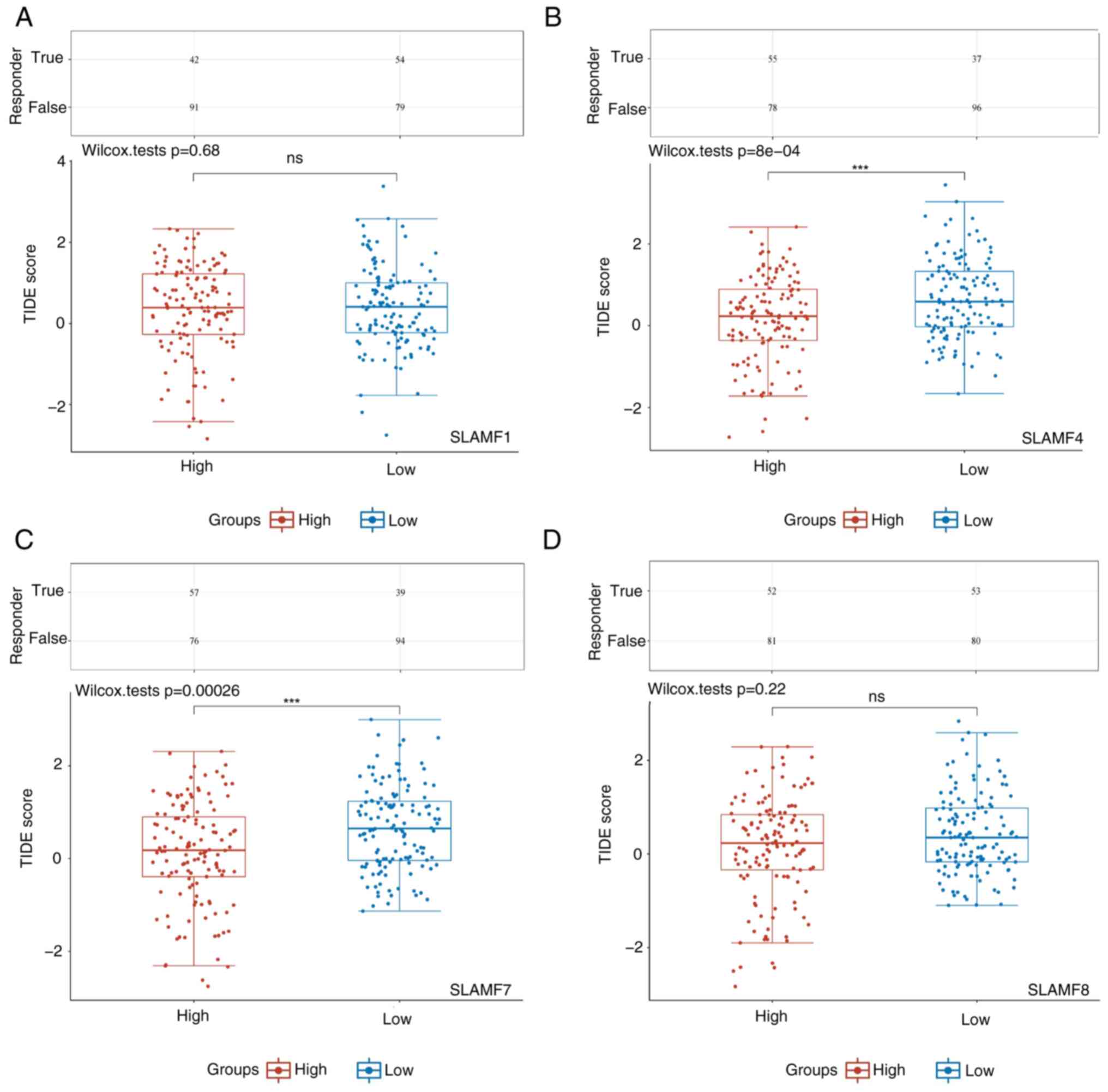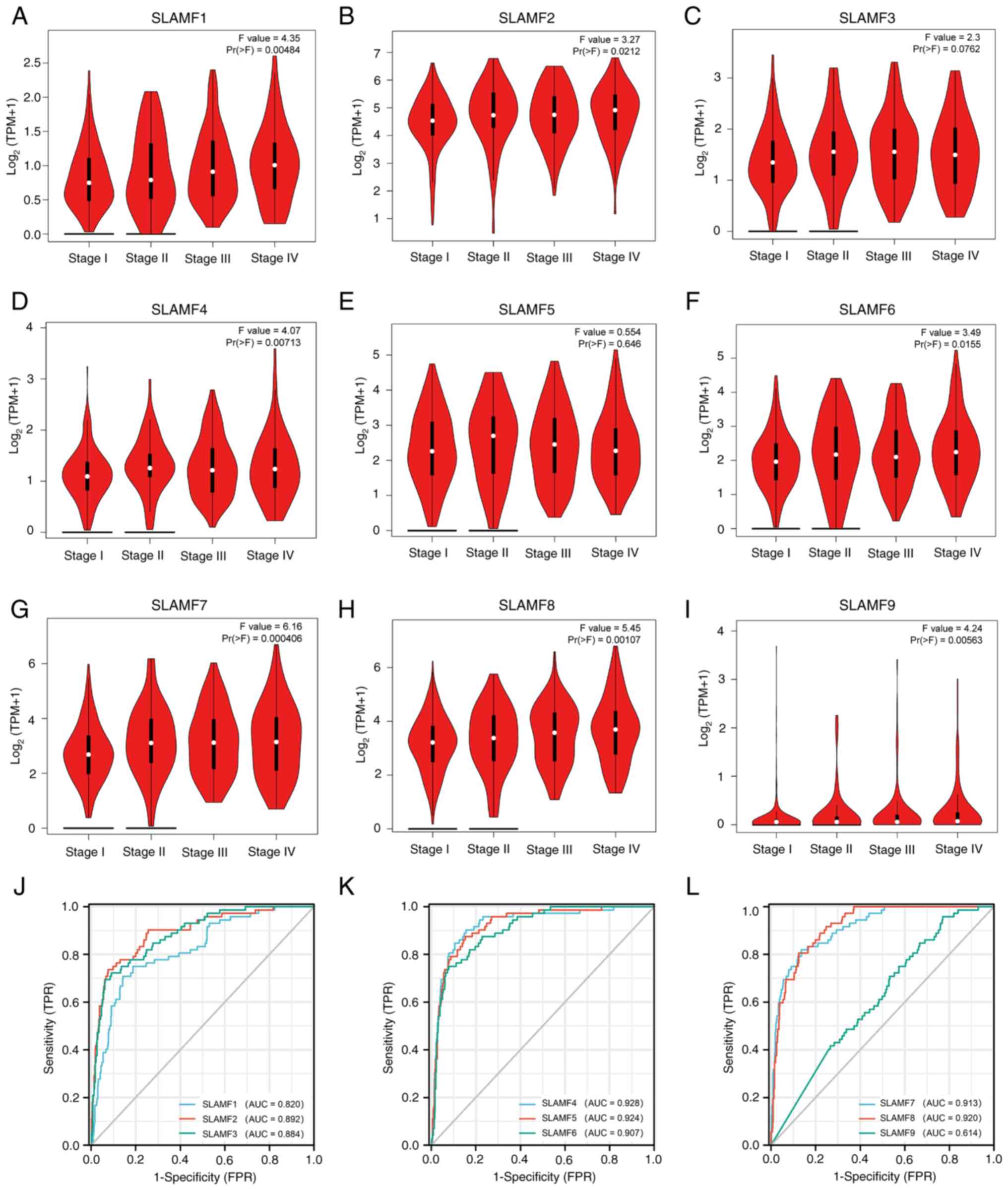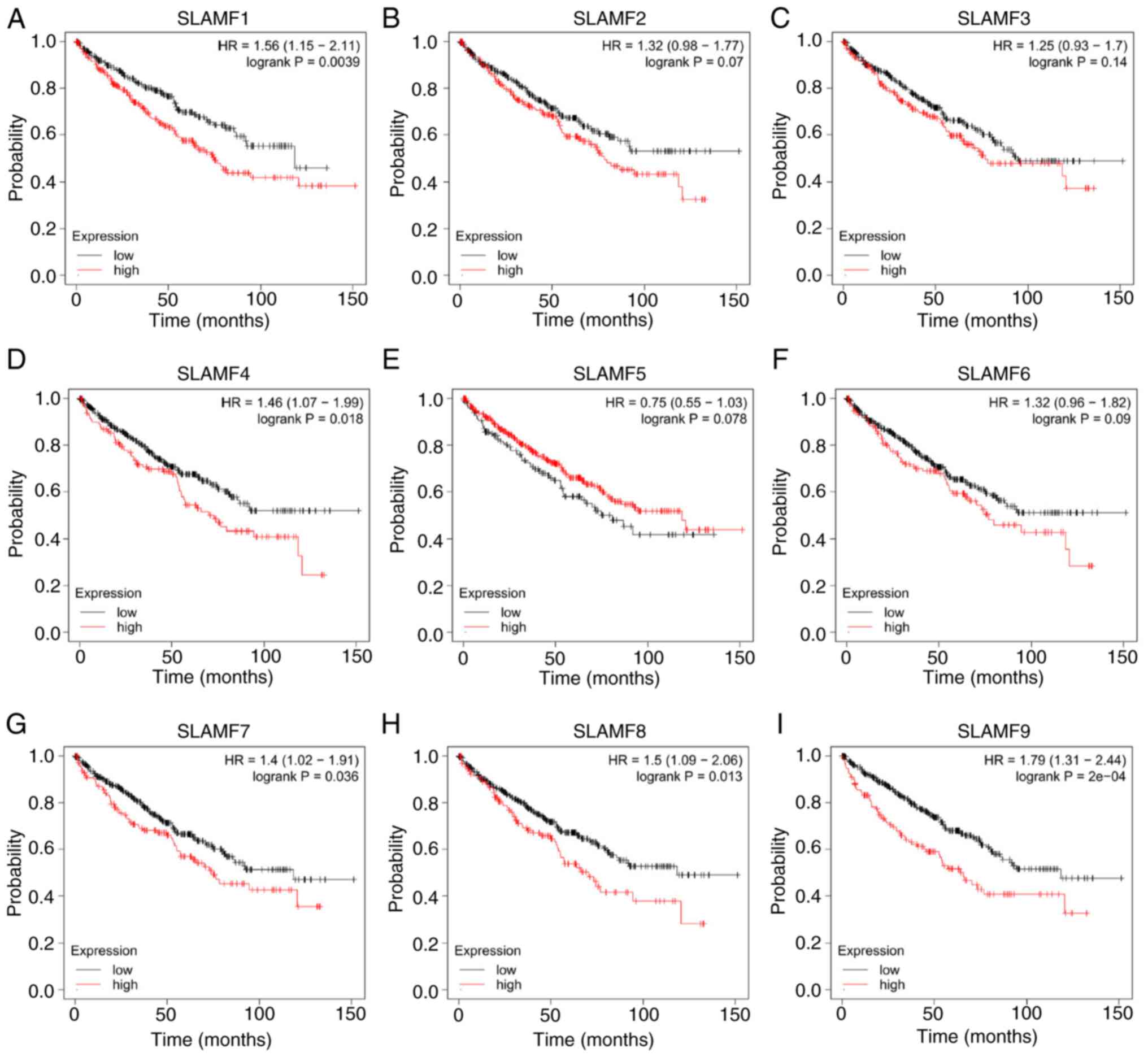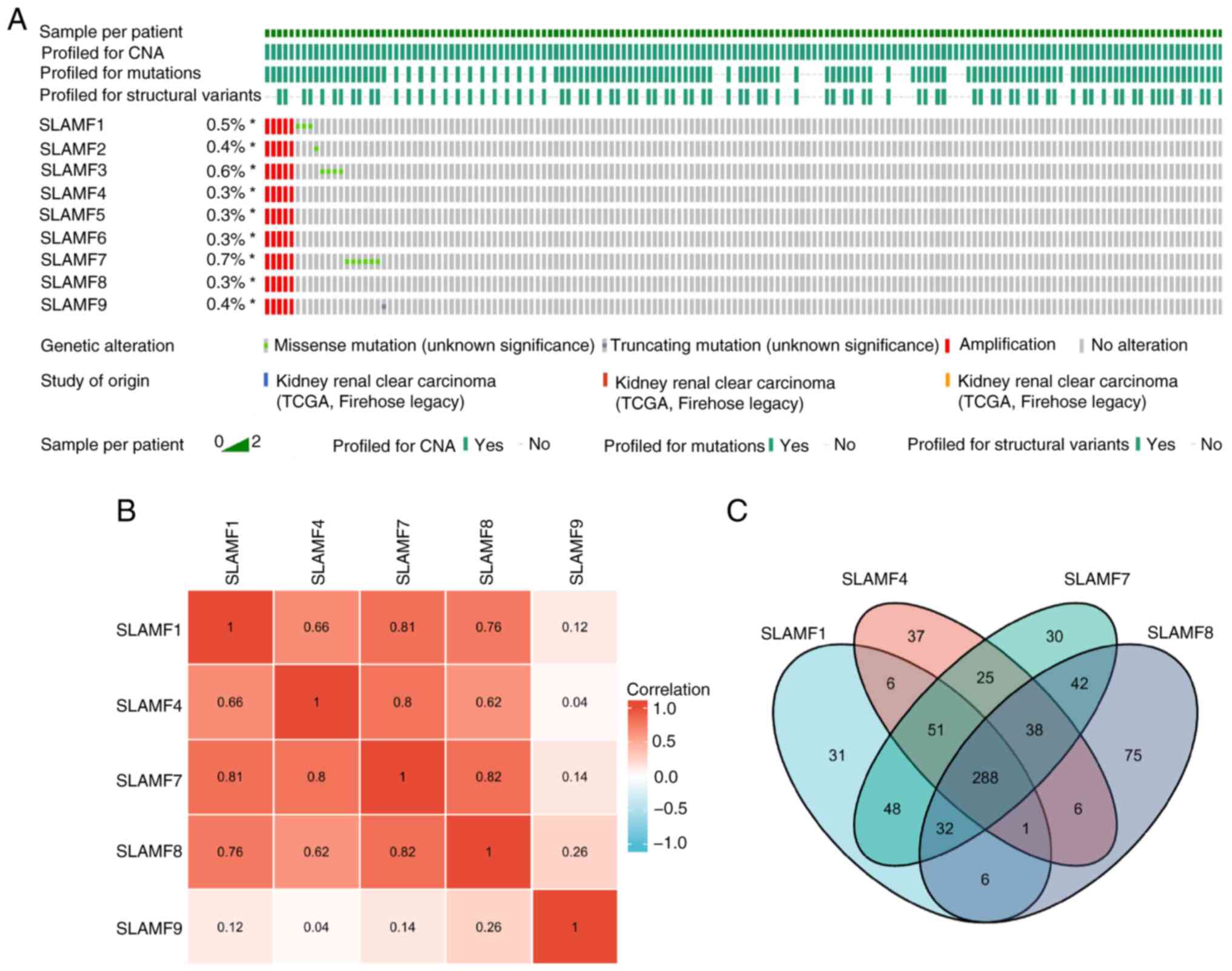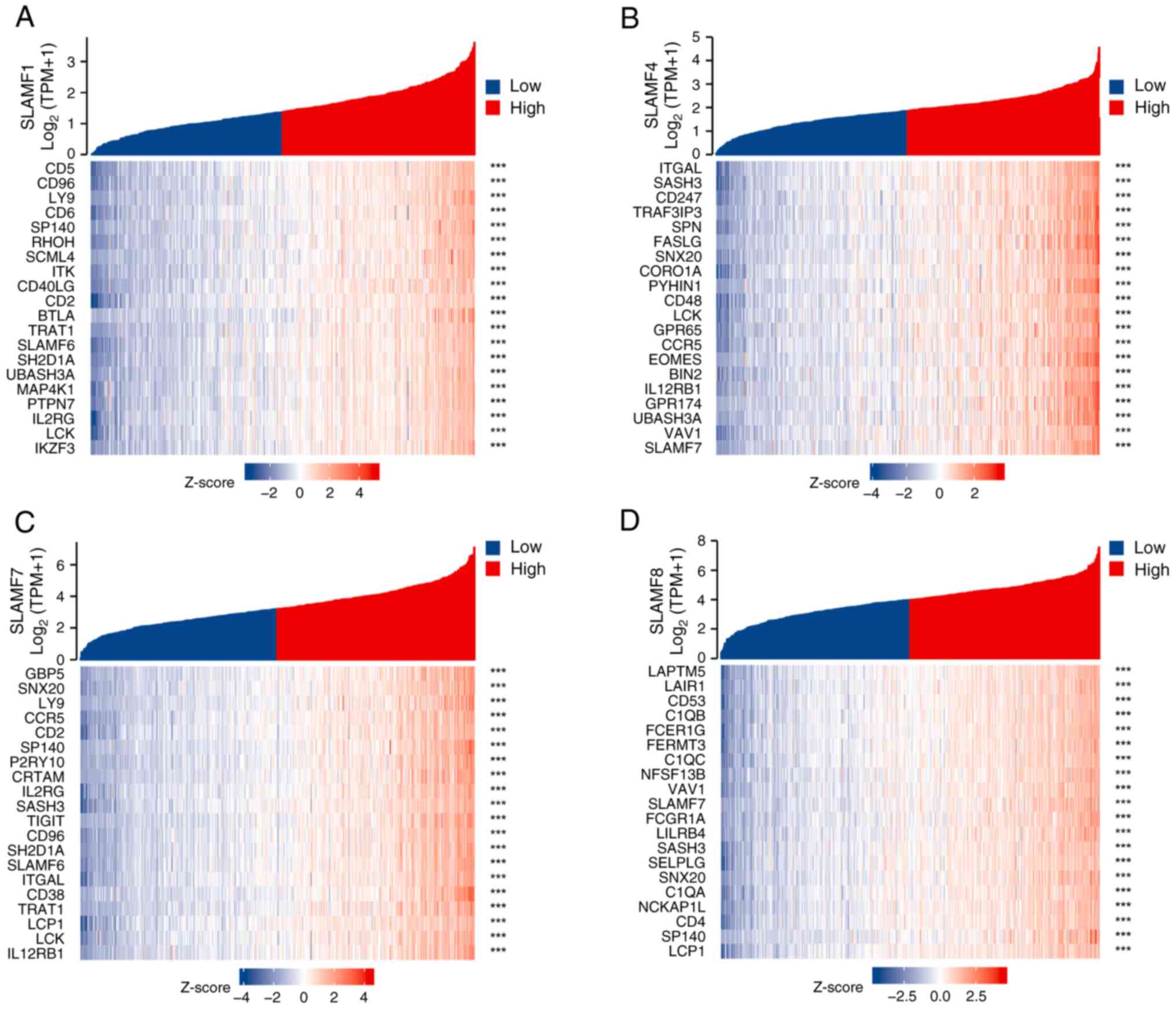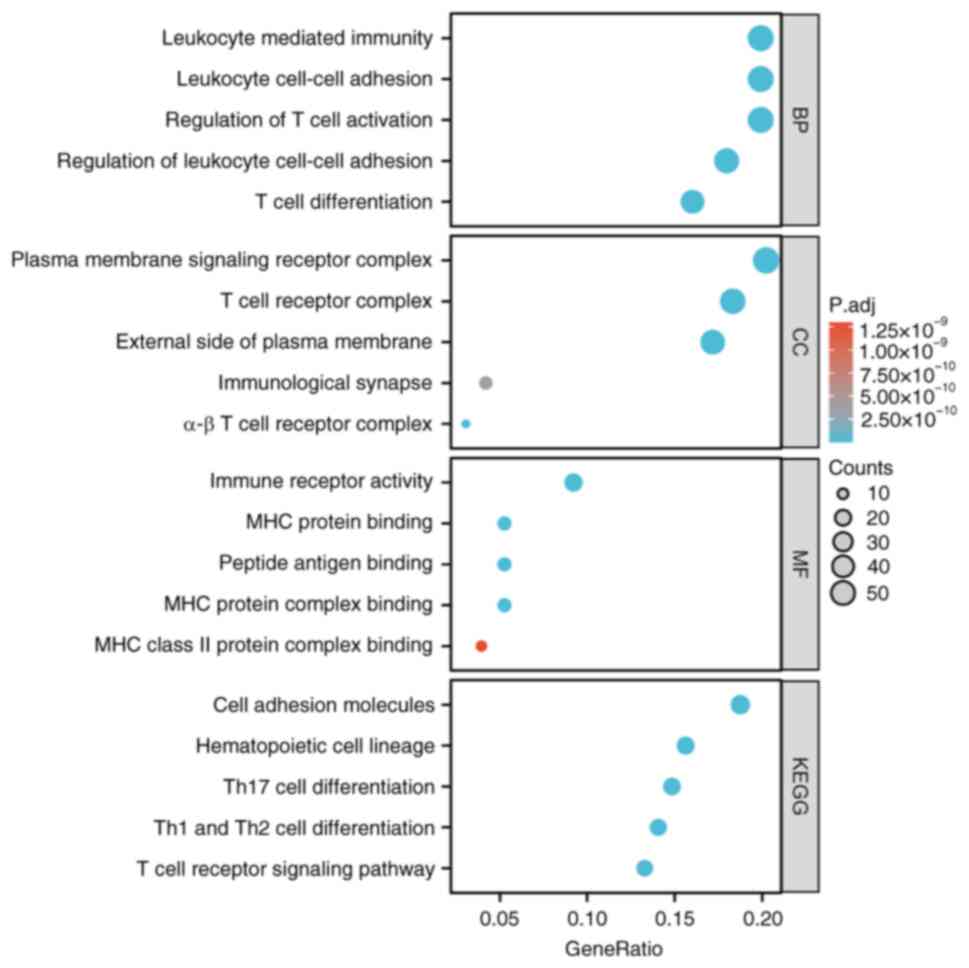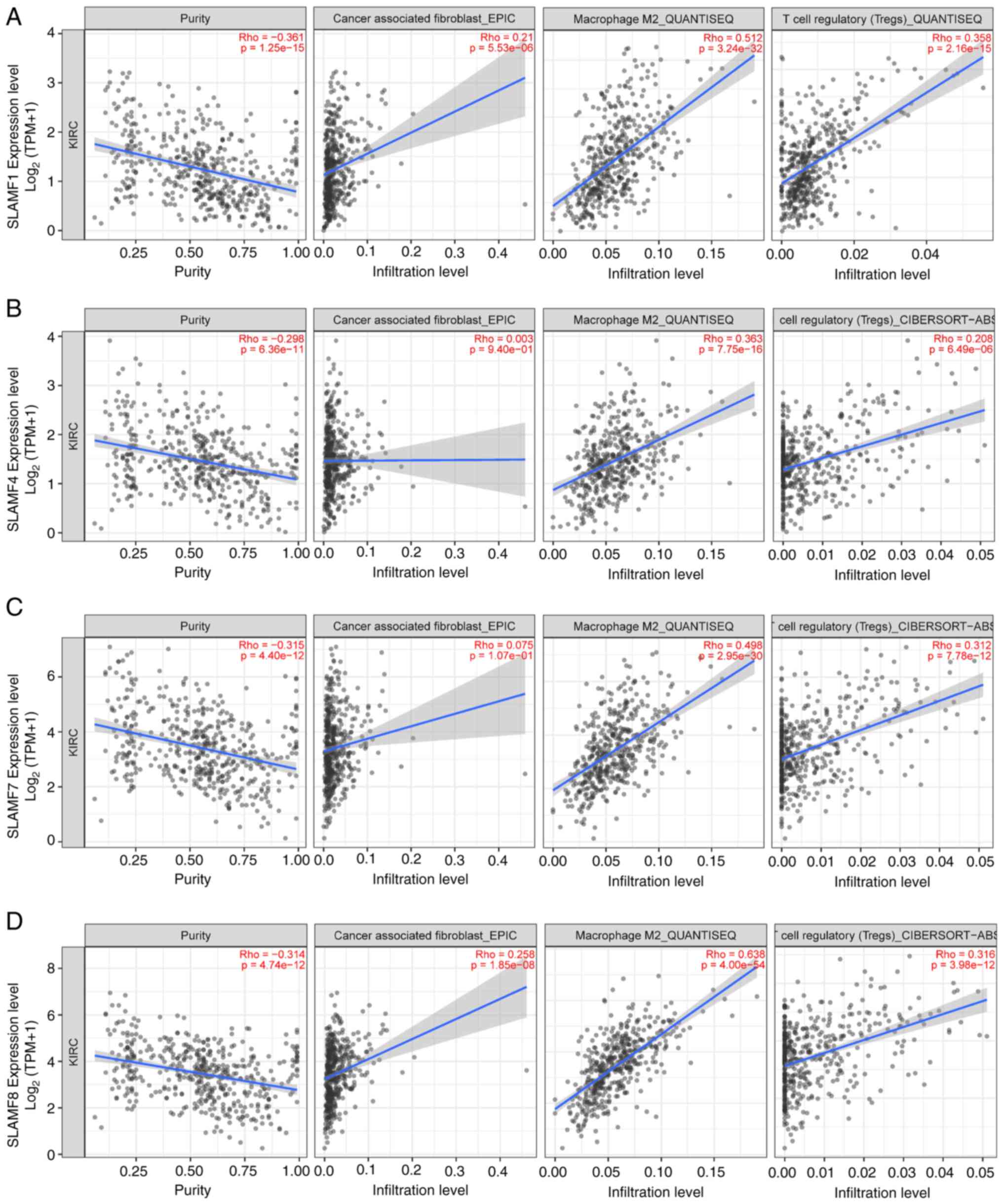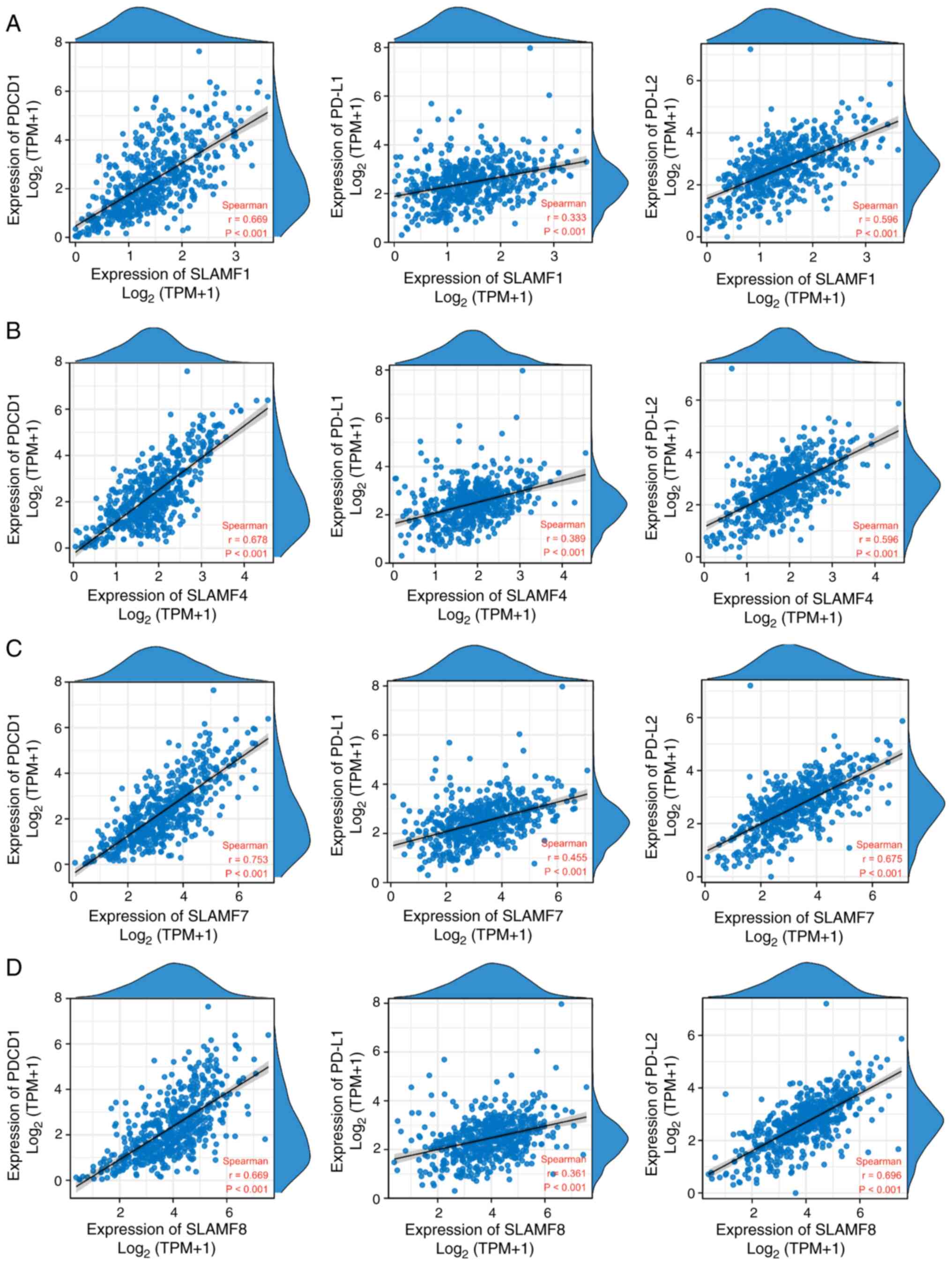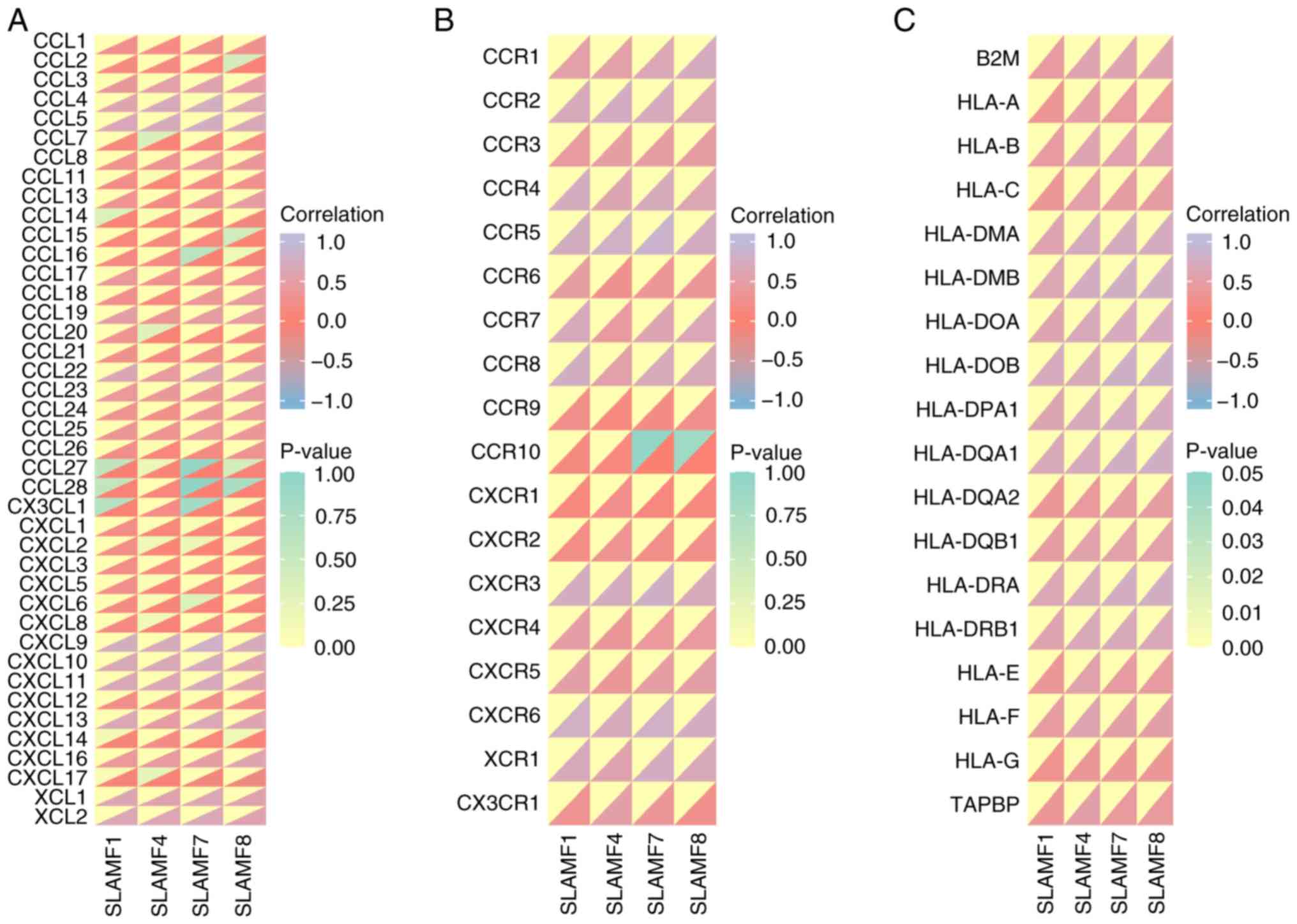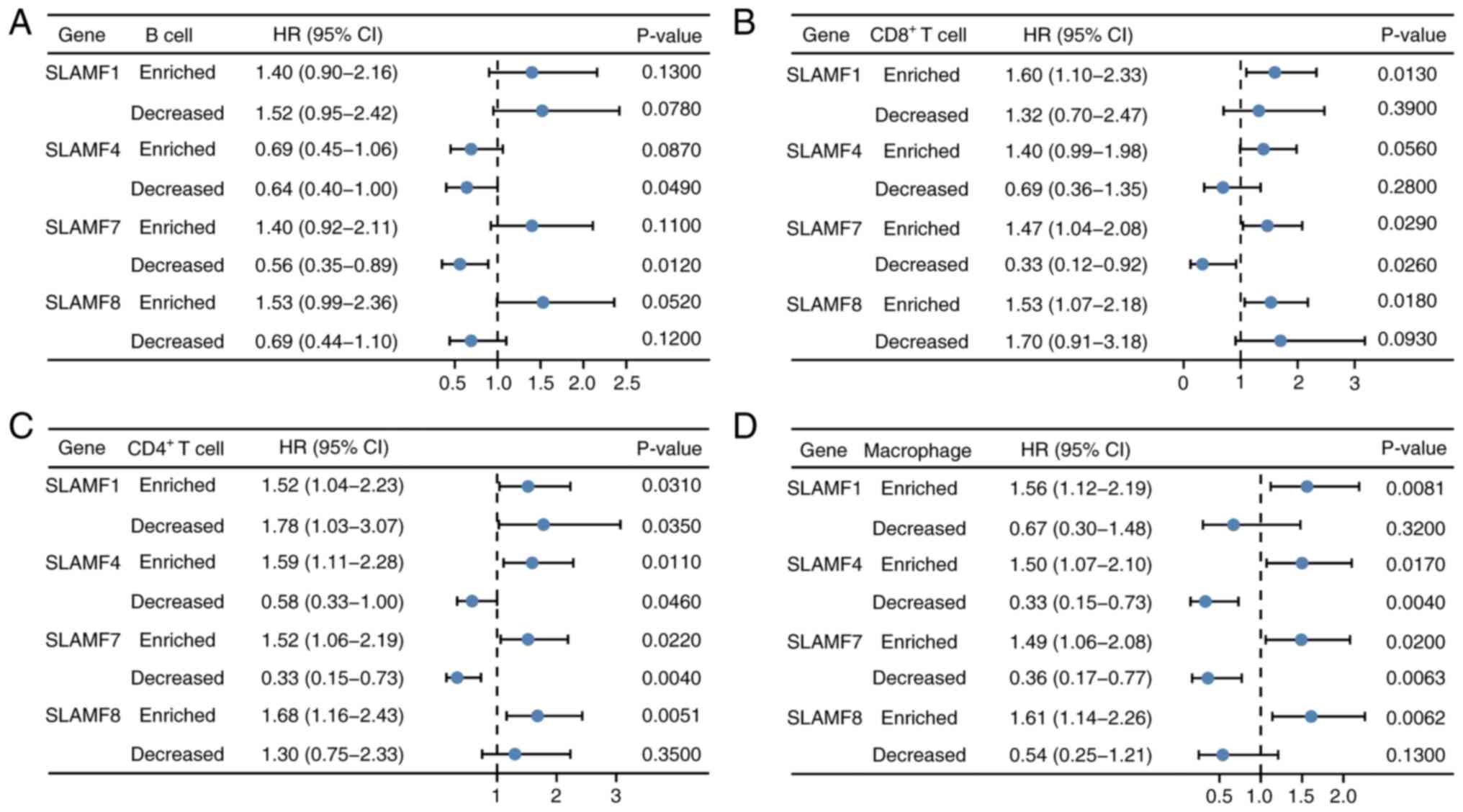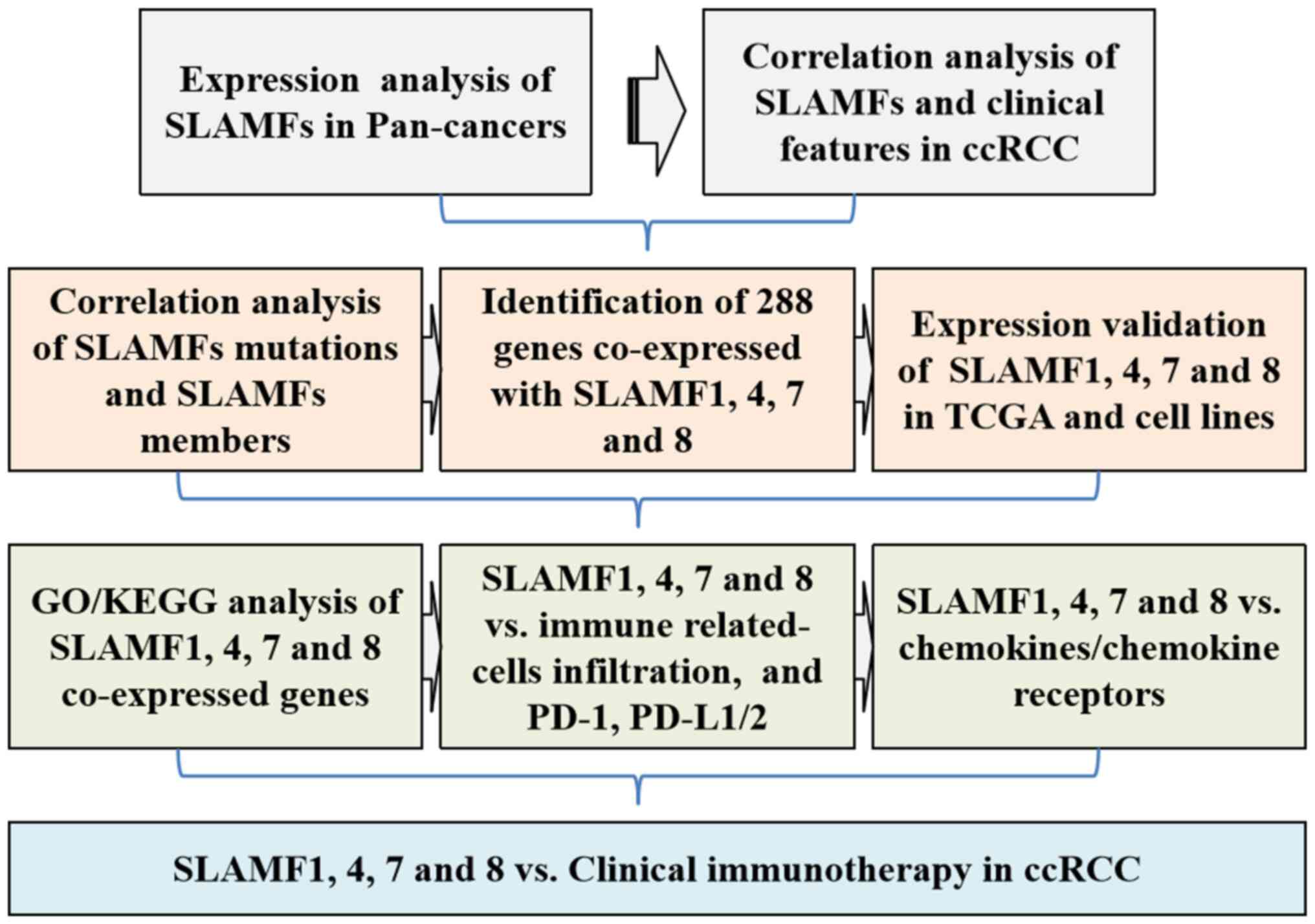Comprehensive analysis of signaling lymphocyte activation molecule family as a prognostic biomarker and correlation with immune infiltration in clear cell renal cell carcinoma
- Authors:
- Published online on: June 3, 2024 https://doi.org/10.3892/ol.2024.14487
- Article Number: 354
-
Copyright: © Song et al. This is an open access article distributed under the terms of Creative Commons Attribution License.
Abstract
Introduction
Renal cell carcinoma (RCC) is one of the most common cancers in the world, ranking sixth and tenth in men and women, respectively (1). Clear cell (cc)RCC accounts for 75–80% of all instances of RCC, with the remaining % comprised of several non-cc cancer subtypes (2,3). The incidence of ccRCC, also known as kidney renal clear cell carcinoma (KIRC), has progressively increased in recent years, accounting for ~5% of adult malignant tumors (4,5). Therefore, its treatment and development warrant increased attention. Early ccRCC is often overlooked by patients due to its mild symptoms, such as fever and fatigue, with ~30% of patients already presenting with metastasis at the time of diagnosis (6–8). Although surgery can be used for tumor removal, ~25% of patients still experience relapse and metastasis (9). The 5-year survival rate is notably high at 90% for early ccRCC but drops to ~33.3% for advanced cases (10).
In recent years, the widespread use of immune checkpoint inhibitors (ICIs) in tumor therapy, especially for ccRCC, has marked revolutionary progress. Immunotherapy demonstrates a significant advantage over conventional chemotherapy, radiation therapy and standard tyrosine kinase inhibitor therapy, either alone or combined with other agents such as nivolumab plus ipilimumab or cabozantinib, pembrolizumab plus axitinib or lenvatinib, and avelumab plus axitinib (11). Additionally, several biological target molecules associated with the diagnosis and prognosis of RCC immunotherapy have been elucidated, including programmed cell death ligand 1 (PD-L1), tumor mutation burden and specific single gene mutations, such as Von Hippel-Lindau, polybromo 1, SET domain containing 2, breast cancer gene 1-associated protein 1 and lysine demethylase 5C. Moreover, DNA-damage repair gene alterations, including common mutations like checkpoint kinase 2, ataxia telangiectasia mutated kinase, MutS homolog 6 and MutY DNA glycosylase, are associated with immunotherapy (12). There are highly infiltrating immune cells in ccRCC, and it was one of the first cancers used in immunotherapy (13); however, the molecular mechanism of ccRCC development is still unclear. Furthermore, the results of a meta-analysis by Santoni et al (14) demonstrated that sex-related differences in the efficacy of ICIs remain an important but undiscussed aspect in cancer immunotherapy trials. In addition, clinical trials should emphasize assessment such as quality of life (15) and European Cancer Organization performance status (16) when evaluating the treatment effect of ICIs in RCC.
The signaling lymphocyte activation molecule family (SLAMF) is a group of receptors that are closely associated with the immune system. They are mainly expressed in hematopoietic cells and immune cells, and they have also been reported in cancer cells (17,18). The family has nine members, including SLAMF1 (CD150), SLAMF2 (CD48), SLAMF3 (CD299; Ly-9), SLAMF4 (CD244, 2B4), SLAMF5 (CD84), SLAMF6 (CD352; Ly108; NTB-A), SLAMF7 (CD319; CRACC; CS1), SLAMF8 (CD353; BLAME) and SLAMF9 (CD84H1; CD2F10; SF2001) (19). Increasing research results indicate that SLAMFs serve a crucial role in tumor immune regulation (18,20). SLAMF1 and SLAMF3 have been reported to be the key genes regulating immune infiltration in ovarian cancer (21). The activation of SLAMF5 upregulates PD-L1 expression and myeloid-derived suppressor cells formation, inhibiting T cell function (22). Reduced SLAMF7 in mouse models leads to decreased programmed cell death protein 1 (PD-1) in CD8+ T cells, reducing T cell failure and tumor progression (23). Additionally, SLAMF4 and SLAMF6 are associated with immune cell exhaustion (24,25). However, the molecular mechanism of SLAMFs in ccRCC remains insufficiently investigated.
In the present study, the expression of SLAMFs in ccRCC was analyzed on the basis of The Cancer Genome Atlas (TCGA) and Genotype-Tissue Expression (GTEx) data. The relationship between SLAMFs expression and prognosis in ccRCC was assessed using the Kaplan-Meier database. Finally, the Tumor Immune Estimation Resource (TIMER) was used to assess the correlation of SLAMFs with immune infiltration. The findings of the present study contribute to the understanding of the molecular mechanisms of SLAMFs in ccRCC development.
Materials and methods
mRNA expression levels of SLAMFs in cancers
TCGA (https://portal.gdc.cancer.gov/) is a comprehensive cancer analysis database that contains data, such as mRNA expression, micro mi(RNA) expression, patient clinical information and methylation. The GTEx portal (https://www.genome.gov/Funded-Programs-Projects/Genotype-Tissue-Expression-Project) serves as a database for transcriptome sequencing of human tissues (26). Data from the TCGA and GTEx databases were downloaded and processed for analysis in the present study (27). The mRNA levels of SLAMFs in 33 cancer and paracancerous tissues were assessed using R software (version 4.2.0; The R Foundation). Additionally, the transcription levels of SALMF1/4/7/8 in ccRCC cell lines were evaluated based on GSE20491 (https://www.ncbi.nlm.nih.gov/geo/query/acc.cgi?acc=GSE20491).
Analysis of SLAMFs with clinical characteristics
Gene Expression Profiling Interactive Analysis (GEPIA)2 (http://gepia2.cancer-pku.cn/#index) is a comprehensive web server designed for large-scale expression profiling and interactive analysis. It encompasses modules such as gene expression modules, prognostic modules and clinical features modules (28). The University of Alabama at Birmingham Cancer data analysis Portal (UALCAN; http://ualcan.path.uab.edu/index.html) is a dedicated portal for facilitating tumor subgroup gene expression and survival analyses (29). The correlations of SLAMFs with clinical features of ccRCC, such as cancer stage, ethnicity, sex, age, tumor grade and lymph node metastasis, were assessed using the GEPIA2 and UALCAN databases.
Analysis of diagnostic value and survival rate
Receiver operating characteristic (ROC) analysis, a widely accepted method for analyzing and comparing diagnostic accuracy (30), was used to assess the diagnostic value of SLAMFs in ccRCC. The area under the curve (AUC) from the ROC curves, indicative of the diagnostic value, was calculated using data from the TCGA database. To evaluate the impact of SLAMFs on survival in cancers, especially ccRCC, the Kaplan-Meier Plotter (http://kmplot.com/analysis) was used. This platform incorporates data on 30,000 genes (mRNA, miRNA and protein) and covers 21 types of tumors (31). The overall survival (OS) of SLAMFs in ccRCC was analyzed using the Kaplan-Meier Plotter with default settings, and the data set of kidney renal clear cell carcinoma (n=530) was used for this analysis.
Analysis of gene mutations and correlation
The cBioPortal website (https://www.cbioportal.org/) serves as a comprehensive database for assessing the genomic features of tumors. Currently, it stores genomic information, such as DNA copy number data, mRNA and miRNA expression data, non-synonymous mutations and protein level and phosphoprotein level data. Gene alterations of SLAMFs were evaluated using the cBioPortal portal (32,33). Furthermore, an analysis of the correlations and co-expression of genes with SLAMFs in ccRCC was performed using the TCGA database. Genes with a correlation coefficient >0.6 and P<0.001 were screened. The intersection of co-expressed genes of SLAMFs was depicted using an online Venn diagram tool (http://bioinformatics.psb.ugent.be/webtools/Venn/). Subsequently, the top 20 co-expressed genes were selected, and their correlations to SLAMFs were plotted.
Gene enrichment analysis
The Gene Ontology (GO) database (http://geneontology.org/) categorizes protein function into three components based on its biological information: Biological process (BP), cellular component (CC) and molecular function (MF). Additionally, the Kyoto Encyclopedia of Genes and Genomes (KEGG) database (https://www.genome.jp/kegg/) was used to assess the pathways associated with the genes. To evaluate the molecular mechanism of ccRCC, GO/KEGG analyses of the co-expressed genes related to SLAMFs were performed. The threshold for GO/KEGG analysis was P.adj<0.05, and the threshold for gene count with the default setting was >1. Furthermore, gene set enrichment analysis (GSEA) of the co-expression genes of SLAMFs was performed (34). The gene sets used for GSEA were obtained from the Molecular Signatures Database (https://www.gsea-msigdb.org/gsea/msigdb/index.jsp).
Analysis of immune cell infiltration and somatic copy number
TIMER (https://cistrome.shinyapps.io/timer) is a web server designed for the comprehensive analysis of tumor-infiltrating immune cells (TIICs) in several cancer types based on TCGA (35). The abundance of TIICs, including B cells, CD4+ T cells, CD8+ T cells, neutrophils, macrophages and dendritic cells, was evaluated using the TIMER portal. The estimate algorithm was used to analyze the immune score in the overall internal environment of ccRCC. Furthermore, the somatic copy number alterations (SCNA) module in TIMER was used to assess the relationship between SLAMFs SCNA and tumor immune-related cell infiltration levels (35). Additionally, the Tumor Immune Dysfunction and Exclusion (TIDE) score was used to assess the efficacy of immune checkpoint blockade (ICB) in ccRCC with high and low expression of SLAMF (4,9,17,21,36).
Correlation analysis of SLAMFs with immunoinhibitory checkpoints
TIMER2.0 (http://timer.cistrome.org/) offers three modules, immunity, exploration and estimation, to assess the associations between immune infiltrates and genetic or clinical features based on the TCGA cohorts (37). In comparison with TIMER, TIMER 2.0 provides more detailed information on immune infiltrates cells. The present study used TIMER 2.0 to evaluate the correlation between three tumor-related immune cells [(M2, Treg and cancer-associated fibroblasts (CAFs)] and the expression of SLAMFs by three algorithms (EPIC, QUANTISEQ and CIBERSORT-ABS). Additionally, using R software (version 4.2.0), the correlations between PD-1, PD-L1, PD-L2 and SLAMF were assessed.
Correlation analysis of SLAMFs with immune-related molecules
Chemokine/chemokine receptors serve a crucial role in the development and homeostasis of the immune system, influencing several immune and inflammatory responses (38). Furthermore, chemokine/chemokine receptors are implicated in several essential steps of tumor metastasis, such as tumor cell adhesion, vascular extravasations, metastatic colonization, angiogenesis and proliferation (39). In addition, major histocompatibility complex (MHC) molecules are key players in antigen presentation and the induction of immune responses (40). Therefore, an analysis was performed to assess the correlations between SLAMFs expression and chemokines/chemokine receptors, as well as with MHC molecules in ccRCC.
Effects of immune cells combined with SLAMFs on the prognosis of ccRCC
The Kaplan-Meier plotter website was used to analyze the impact of SLAMFs on the prognosis of ccRCC considering changes in the content of immune cells. Using the four types of immune cells available in the TIMER database (https://cistrome.shinyapps.io/timer) (35), namely B cells, CD4+ T cells, CD8+ T cells and macrophages, their effects on the prognosis of patients with ccRCC in relation to SLAMFs expression was assessed.
Cell culture and reverse transcription-quantitative polymerase chain reaction (RT-qPCR)
The cell lines were purchased from Pricella (Procell Life Science & Technology Co., Ltd.), and the reverse transcription kit was purchased from Thermo Fisher Scientific, Inc. Human ccRCC 786-O and 769-P cell lines were cultured in an incubator (37°C; 5% CO2) in RPMI 1640 medium containing 10% fetal bovine serum (cat. no. C04001; ViaCell Inc.) and 1% penicillin/streptomycin (cat. no. C0222; Beyotime Institute of Biotechnology) for 2 days. To assess the expression levels of SLAMF1/4/7/8 in the ccRCC cell lines, cell clusters from 786-O and 769-P were extracted. Total RNA was extracted with RNAiso PLUS (cat. no. 9108; Takara Bio, Inc.), and then cDNA was synthesized using the RevertAid First Strand cDNA Synthesis Kit (cat. no. K1622; Thermo Fisher Scientific, Inc.) according to the instructions provided by the manufacturer. qPCR was performed with UltraSYBR Mixture containing high ROX (cat. no. CW2602M; CoWin Biosciences) following the manufacturer's instructions. The mRNA expression of SLAMF members in ccRCC cell lines was assessed using the human kidney HK-2 cell line as control cells and 18S rRNA as an internal reference. The primers for RT-qPCR were designed by PrimerBank (The Massachusetts General Hospital; http://pga.mgh.harvard.edu/primerbank/index.html) (41) and the sequences are as follows: SLAMF1 (NM_003037), sense: 5′-GGAGAACAGTGTCGAGAACAAA-3′ and antisense: 5′-CGTATCCCCAGGGTGAGATTC-3′; SLAMF4 (also known as CD244, NM_001166663), sense: 5′-TCGTGATTCTAAGCGCACTGT-3′ and antisense: 5′-CAGGTTCTTGTGACGTGGGAG-3′; SLAMF7 (NM_021181), sense: 5′-GGCAGCTCACAGGGTCAG-3′ and antisense: 5′-GGGTTGTGTTGAAGGTCCAGA-3′; SLAMF8 (NM_020125), sense: 5′-CTTCTCTGGGAAGATGCAGTG-3′ and antisense: 5′-TTTCGCTGATGTTGGGGGC-3′; 18S rRNA, sense: 5′-GTAACCCGTTGAACCCCATT-3′ and antisense: 5′-CCATCCAATCGGTAGTAGCG-3′ (42). Relative mRNA expression was calculated using the comparative 2−ΔΔCq method (43).
Statistical analysis
All analyses were performed using R software (version 4.2.0; The R Foundation; http://www.r-project.org/) (44), with graph making and statistical analysis using the Xiantao Academic Platform (www.xiantaozi.com) and GraphPad (version 9.5.1). The Wilcoxon rank-sum test was used to analyze differences in expression in Figs. 1A, S1, 5E, 8B and 13. The paired t-test was used to analyze differences in Fig. 1C. One-way ANOVA was performed on the GEPIA website to analyze the differences in gene expression between pathological stage in Fig. 2A-I. One-way ANOVA with Tukey's honestly significant difference test was used for analysis of Fig. 5A-D and F. Spearman's rank was used for correlation analysis. pROC package (version 1.17.0.1) (https://cran.r-project.org/web/packages/pROC/index.html) was used for the ROC curve analysis, whilst the clusterprofiler package (version 3.14.3) was used for enrichment analysis and visualization (45). The estimate package (version 1.0.13) (https://rdrr.io/rforge/estimate/) was used to analyze the immune score (46). P<0.05 was considered to indicate a statistically significant difference.
Results
Increased transcription levels of SLAMFs in ccRCC
To compare the expression of the SLAMFs in tumor with normal tissues, the mRNA levels of the SLAMFs were assessed using TCGA and GTEx data. The results revealed significantly elevated expression of SLAMFs in esophageal carcinoma, glioblastoma multiforme, KIRC, low-grade glioma, pancreatic adenocarcinoma, skin cutaneous melanoma and stomach adenocarcinoma compared with corresponding normal tissues (Figs. 1A and SI). Additionally, SLAMFs (excluding SLAMF4) demonstrated significantly high expression in ovarian cancer and testicular cancer compared with normal tissue (Figs. 1A and S1). Moreover, the expression of SLAMFs in ccRCC was analyzed using both paired and unpaired methods. The results demonstrated that the mRNA expression level of SLAMFs in tumor tissues were significantly higher than those in normal tissues (Fig. 1B and C).
SLAMFs are highly associated with clinical features
To assess the association between SLAMFs with clinical characteristics, two online analysis tools were used. The results from the GEPIA2 database indicated that SLAMF3 and 5 demonstrated no statistically significant association with ccRCC staging; however, SLAMF1, 2, 4, 6, 7, 8 and 9 were significantly associated with the staging of ccRCC (Fig. 2A-I). Additionally, results from the UALCAN database indicated that SLAMFs were significantly associated with ethnicity, sex, age, tumor grade, ccRCC subtypes and nodal metastasis status. Compared with lower grade and lower age group, higher expression of SLAMFs was observed with significantly higher tumor grade and age. The ccB subtype in ccRCC demonstrated a significantly stronger association with SLAMF expression compared with the ccA subtype (SLAMF1, 3, 7, 8 and 9) (Table SI). These findings suggest that SLAMFs may contribute to the progression of ccRCC.
Prognosis of SLAMFs and associations among members
The diagnostic value of SLAMFs was assessed using ROC analysis, revealing high diagnostic values for SLAMF1-8 with corresponding AUC values of 0.820, 0.892, 0.884, 0.928, 0.924, 0.907, 0.913 and 0.920, respectively. By contrast, SLAMF9 demonstrated a relatively low diagnostic value, with an AUC value of 0.614 (Fig. 2J-L). Furthermore, to assess the effect of SLAMFs on the survival rate of patients with ccRCC, the effect of high and low expression of SLAMFs on OS were compared (Fig. 3). The results indicated that a high expression of SLAMF1, 4, 7, 8 and 9 was significantly associated with a worse prognosis in ccRCC compared with the low expression groups; however, the expression of SLAMF2, 3, 5 and 6 had no significant association with the prognosis of ccRCC. These findings suggest that certain members of SLAMFs, particularly SLAMF1, 4, 7, 8 and 9, may contribute to a poor prognosis in ccRCC.
Mutation frequency and related genes in SLAMFs
A comprehensive analysis of the mutation, copy number and structure of the SLAMFs was performed, revealing their primary involvement in missense mutations and amplifications (Fig. 4A). According to the analysis results, the main alteration of SLAMFs gene in ccRCC was amplification, that is, the increase in gene copy number, which was associated with an increase in SLAMFs gene expression. This was consistent with the results shown in Fig. 1. Since SLAMFs have a significant effect on the prognosis of patients with ccRCC, the co-expressed genes of SLAMF1, 4, 7, 8 and 9 were screened. A notably strong correlation was revealed for SLAMF1, 4, 7 and 8 (Fig. 4B). Subsequently, co-expressed genes were screened for each SLAMF in ccRCC, resulting in 463 co-expressed genes identified for SLAMF1, 452 for SLAMF4, 544 for SLAMF7, and 488 co-expressed genes for SLAMF8. In total, 288 co-expressed genes were identified for SLAMF1, 4, 7 and 8 (Fig. 4C). Additionally, the association between SLAMF1, 4, 7 and 8 expression levels with different tumor-node-metastasis staging and grading was analyzed (Fig. 5A-D). In addition, the expression of SLAMF1, 4, 7 and 8 in ccRCC cell lines (786-O and 769-P) was higher compared with that in a normal renal epithelial cell line (HK-2) (Fig. 5E and F). Furthermore, the top 20 genes that were among the 288 co-expressed genes associated with SLAMF1, 4, 7 and 8 were assessed (Fig. 6) (P<0.05).
SLAMFs are associated with immune activation
GO/KEGG analysis was performed on 288 co-expressed genes associated with SLAMF1, 4, 7 and 8. The GO and BP analysis demonstrated significant associations between T cell activation, regulation of T cell activation, regulation of lymphocyte activation, leukocyte cell-cell adhesion and positive regulation of cell activation and SLAMF co-expression genes. CC analysis highlighted a significant association between T cell receptors, whilst MF analysis reveal a significant association with cytokines/cytokines receptor activity and SLAMF co-expression genes (P.adj<0.05; Fig. 7 and Table SII). KEGG pathway enrichment analysis demonstrated that SLAMFs co-expression genes were significantly associated with cell adhesion molecules (CAMs), hematopoietic cell and helper T 1, 2 and 17 immune cell differentiation, and T cell receptor signaling pathway (Fig. 7). In addition, KEGG enrichment analysis was performed using the top 20 co-expressed genes associated with SLAMF1, 4, 7 and 8 in (P.adj<0.05; Table SII). GSEA indicated involvement in pathways such as the Jak-stat signaling pathway, toll like receptor signaling pathway, B cell receptor signaling pathway and nod like receptor signaling pathway (Table SIII). These findings suggested that SLAMFs and their co-expressed genes may participate in the regulating of the immune system function and contribute to the development of ccRCC.
SLAMFs promote the infiltration of immune cells
The TIMER results indicated that SLAMF1, 4, 7 and 8 were positively correlated with infiltration levels of B cells, CD4+ T cells, CD8+ T cells, macrophages, neutrophils and dendritic cells in ccRCC (Fig. 8A). To further assess these findings, the correlations between SLAMF1, 4, 7 and 8 and immune cell gene markers were analyzed, including B cells, CD8+ T cells, T cells, monocytes, tumor-associated macrophages (TAMs), M1 macrophages, M2 macrophages and T cell exhaustion (Table SIV, Table SV, Table SVI, Table SVII). The results demonstrated that SLAMF1, 4, 7 and 8 were significantly positively correlated with gene markers of immune cells. This suggests that SLAMFs can promote immune cell infiltration in the tumor microenvironment (TME). Analysis of SCNA revealed that arm-level deletion of SLAMF1, 4, 7 and 8 was significantly associated with decreased infiltration levels of B cells, CD4+ T cells, CD8+ T cells, macrophages, neutrophils and dendritic cells (Fig. 8B; P<0.001). Moreover, the level of immune infiltration in the ccRCC strongly and significantly correlated with the expression of SLAMF1, 4, 7 and 8 (Fig. 8C). In summary, the results indicate that SLAMF1, 4, 7 and 8 can promote immune cells infiltration in ccRCC.
Association of the SLAMFs with immunoinhibitors
A total of three algorithms were used (EPIC, QUANTISEQ and CIBERSORT-ABS) based on the TIMER database to analyze the correlations between the infiltration levels of M2 macrophages, Treg cells and CAFs in ccRCC and the expression of SLAMFs (Fig. 9). The infiltration levels of M2 macrophages and Treg cells were significantly positively correlated with the expressions of SLAMF1, 4, 7 and 8. Meanwhile, the infiltration level of CAFs was only significantly correlated with the expression of SLAMF1 and 8. Nevertheless, the overall trend indicates a notable upregulation of tumor-related immune cells with increased expression of SLAMF members. Additionally, PD-1 is a crucial immunosuppressive molecule (47), and the results of the present study demonstrated that the expression of SLAMF1, 4, 7 and 8 was significantly positively correlated with the expression of PD-1 and its ligands PD-L1 and PD-L2 in ccRCC (Fig. 10). These findings suggest that SLAMF may inhibit the tumor-killing effect of immune cells via PD-1 and tumor-associated immune cells.
Association between chemokines/chemokine receptors with SLAMFs
Based on the results of the functional analysis of SLAMFs, the association between cytokines and SLAMFs were further assessed. The findings revealed that the SLAMF1, 4, 7 and 8 were generally positively associated with chemokines/chemokine receptors in ccRCC (Fig. 11A and B). Moreover, C-C motif chemokine ligand (CCL)4, CCL5, C-X-C motif chemokine ligand (CXCL)9, CXCL10, CXCL11, X-C motif chemokine ligand (XCL)1, XCL2, C-C motif chemokine receptor (CCR)1, CCR2, CCR4, CCR5, CCR8, C-X-C motif chemokine receptor (CXCR)3, CXCR6 and X-C motif chemokine receptor 1 were significantly correlated with SLAMF1, 4, 7 and 8 exhibited (r>0.5; P<0.001). As the main molecules in antigen presentation, MHCs were also demonstrated to be significantly positively correlated with SLAMF1, 4, 7 and 8 (P<0.001; Fig. 11C) (48). These results suggest that SLAMFs may promote immune cell infiltration in ccRCC through interactions with chemokines and MHCs.
Increased level of immune cell infiltration affects the prognosis of SLAMFs in ccRCC
A prognosis analysis of SLAMFs were performed in combination with B cells, CD4+ T cells, CD8+ T cells and macrophages in ccRCC (Fig. 12). Forest plots containing hazard ratio (HR) and P-values were used to present the results. The results showed that, in the group with decreased B cell infiltration levels, ccRCC patients with high expression of SLAMF4 and 7 had a better prognosis than those with low expression of SLAMFs. Patients with ccRCC with high expression of SLAMF1, 4, 7 and 8 had a worse prognosis than those with low expression of SLAMFs in the group with enriched CD4+ T cell infiltration levels, whilst those with high expression of SLAMF1, 4 and 7 had better prognosis in the group with decreased CD4+ T cell infiltration levels. In the group with enriched CD8+ T cell infiltration levels, patients with ccRCC had a worse prognosis with high expression of SLAMF1, 7 and 8 than those with low expression of SLAMFs, whilst those with high expression of SLAMF7 had a better prognosis in the group with decreased CD8+ T cells infiltration levels. In the group with enriched macrophage infiltration levels, patients with ccRCC with high expression of SLAMF1, 4, 7 and 8 had a worse prognosis, whereas those with high expression of SLAMF4 and 7 had a better prognosis in the group with decreased macrophages infiltration levels. These results suggest that SLAMFs may impact the prognosis of patients through the level of immune cell infiltration in ccRCC. Furthermore, the high-expression SLAMF4 and 7 groups had significantly lower TIDE scores, compared with the low-expression groups (Fig. 13). The TIDE score was inversely proportional to ICB efficacy, indicating that a high expression of SLAMF4 and 7 was associated with an improved response to ICB therapy in patients with ccRCC.
Discussion
With the advent of the era of immune-targeted tumor therapy, an increasing number of SLAMF members, which are associated with the immune system, have been extensively studied in several tumors, including head and neck squamous cell carcinoma, gastric cancer, colorectal cancer, ovarian cancer and chronic lymphocytic leukemia (25,49–53). However, research on the role of SLAMF members in ccRCC has been limited. In the present study, a flow chart of the present research is shown in Fig. 14. In addition, it was demonstrated that SLAMF members were differentially expressed in several cancers relative to normal tissues, and notably, the expression of nine SLAMF members was upregulated in ccRCC, providing a compelling rationale for further investigation. Moreover, the high expression of SLAMF was associated with cancer stage, tumor grade and ccRCC subtype. The results also indicated that a high expression of SLAMF members was associated with poor prognosis in patients with ccRCC.
Previous studies reported that SLAMF members strongly bind SLAMF-associated proteins (SAP). They have also identified mutations in SAP in patients with X-linked lymphoproliferative immunodeficiency disease, and reported that reduced SAP exerts inhibitory effects on SLAMF members (54,55). These findings suggest that SLAMF has a regulatory role in the immune system. In the field of cancer, SLAMF members have been reported to have an inhibitory effect on immune responses in the TME, contributing to the immune escape of tumors (50). However, the molecular mechanism of SLAMF members in ccRCC has been rarely studied.
Based on data from TCGA and GTEx, the present study comprehensively explored the biological role of SLAMF in ccRCC for the first time, to the best of our knowledge, including: SLAMF expression and gene changes, clinical characteristics and diagnostic significance, correlation of immune cell infiltration, and prediction of immune checkpoint inhibitor efficacy. The present study lays a theoretical foundation for the future research of SLAMF in ccRCC, especially in immunotherapy. The present study demonstrated that the molecular mechanisms of SLAMF members are associated with immunity, as expected. Furthermore, the pathway enrichment of SLAMF members was associated with CAMs and leukocyte cell-cell adhesion. Cancer migration is a process wherein cancer cells are shed from the primary tumor site and metastasize to distant sites, in which CAMs serve an essential role in this process (56). The metastasis of ccRCC is associated with a poor prognosis for patients with cancer (57), and blocking the metastasis of ccRCC may improve the prognosis. The high expression of SLAMF members may be a factor contributing to ccRCC metastasis and there is evidence that SLAMF members are involved in several physiological and pathological processes, including the regulation of immune responses (58).
In the present study, the high expression of SLAMF members was highly correlated with several immune cells, a finding which is consistent with previous results. There is evidence to suggest that SLAMF1 serves a co-stimulatory role in the activation and differentiation of T and B cells (19), the formation of germinal centers, and antibody production (59,60). Moreover, SLAMF1 is markedly upregulated in CD8+ T cells compared with CD4+ T cells (61). However, in tumor cells, a high expression of SLAMF1 can promote the growth and survival of tumor cells. There are reports that SLAMF1 can mediate the survival and proliferation of tumor cells through the PI3K/Akt signaling pathway, and participate in regulating cell metabolism, proliferation and survival (62,63). SLAMF4 serves a complex role in cancer immunity, acting as an inhibitory immune checkpoint and ‘don't eat me’ receptor on macrophages, hindering tumor cell phagocytosis (64). In CD8+ T cells, particularly in cancers like head and neck squamous cell carcinoma, SLAMF4 expression is notably increased, especially in exhausted T cells expressing other co-inhibitory receptors like PD-1 (50,65). Immunogenic peptides from SLAMF7 antigens activate specific cytotoxic T lymphocyte clones against multiple myeloma (66). In mouse models lacking SLAMF7, tumor growth is slower, and CD8+ T cells express lower levels of PD-1 (23). SLAMF8 is expressed in anaplastic large-cell lymphoma cell lines and serves a role in oncogenic signaling pathways, with knockdown of SLAMF8 associated with a reduction in cell proliferation and an increase in apoptosis (67). High SLAMF8 expression is associated with a worse prognosis in glioma, including reduced OS and chemotherapy resistance (68), but it is correlated with improved efficacy of anti-PD-1 immunotherapy in gastrointestinal cancers (69).
In the present study, based on the gene mutations of SLAMF members, it was demonstrated that the arm-level deletion of SLAMF members was associated with the level of immune cell infiltration in tumors. Furthermore, the effect of the expression of SLAMF members on the prognosis of patients with ccRCC was regulated by immune cells. Specifically, enriched immune cells in patients with ccRCC and high SLAMF expression were associated with a worse prognosis relative to decreased immune cells. Although immune cells resisted tumor cells under normal conditions, the prognosis of ccRCC was poor. Therefore, we hypothesize that tumor cells may inhibit immune cells through several mechanisms to achieve immune escape. The results of the present study demonstrated that the expression of SLAMF was generally positively correlated with the infiltration of CAFs, M2 macrophages and Tregs cells, that is, high expression of SLAMF can promote the infiltration of these cells in the TME. Existing studies had reported that immunosuppressive suppressor cell subsets are transferred to the TME through the secretion of cytokines (including chemokines and interleukins) by CAFs (48,70). Interferon-γ secretion by CD8+ T cells would be inhibited by Tregs, which are immunosuppressive regulatory molecules (71). M2 macrophages, which function as tumor-associated immune macrophages, have also been reported to promote cancer progression in many cancers (72,73). Tregs, CAFs and M2 cells differ from normal immune cells, exerting a negative effect on the immune response. The present study demonstrated that certain SLAMF members inhibited tumor-related immune cell function by promoting the infiltration of tumor immune negative regulatory cells, such as CAFs, M2 macrophages and Tregs cells.
Moreover, PD-1 immunotherapy has made considerable progress in the treatment of several cancers (74). PD-1 mainly binds to two ligands, PD-L1 and PD-L2, participating in the activation of the PD-1 signaling pathway. The activation of the PD-1 signaling pathway can inhibit the activity of T cells, and prevent dendritic cells (DCs) from activating T cells. Therefore, anti-PD-1 treatment is highly beneficial for tumor treatment (75). In the present study, SLAMF members were positively correlated with PD-1 and its ligands PD-L1/2.
Chemokines serve a crucial role in guiding the migration of immune cells. Recent studies have demonstrated that chemokine receptors induce CD8+ T cells and DCs to migrate to the TME by binding to ligands (76). However, Tregs and TAMs are also induced to migrate to the TME, leading to immune tolerance (76). Additionally, chemokines promote tumor progression through several mechanisms, including angiogenesis and metastasis (77). In the present study, the expression of chemokines/chemokine receptors and SLAMF members were positively correlated. Past research has reported that the CCL17/CCL22-CCR4 axis migrated Tregs to the TME; CXCL9/10/11/12-CXCR3/CXCR4 axis migrated CD8+ T cells to the TME; and the CCL2/CCR2 axis migrated TAM to the TME (76). CXCL13+CD8+ T cells could not only exhaust immune cells but also damage the function of CD8+ T cells (78). Furthermore, CCL4 and CCL5 have been reported participate in the proliferation, metastasis and invasion of ccRCC cells (79,80). These findings indicate that although immune cells migrate to the TME, they may inhibit immune function to promote immune escape via chemokines.
In summary, through the analysis of the biological function of SLAMF members in ccRCC, it was demonstrated that SLAMF1, 4, 7 and 8 may serve an important role in ccRCC: They may promote the progression of ccRCC through immune-related pathways and may become new immunotherapeutic targets in the future. The current study has certain limitations that need to be addressed. First, the results are mainly based on bioinformatic analysis of public datasets, and further experimental validation, especially in vivo, as well as validation of clinical samples, are needed to confirm the findings. Second, the expression of SLAMF members, especially SLAMF1, 4, 7 and 8, maybe used as clinical prognostic biomarkers of ccRCC, but the appropriate threshold of their expression levels need to be determined, and the accuracy, feasibility and clinical practicability of expression detection needs to be fully demonstrated in a larger patient population. Third, more clinical trials and population data are needed to further validate the expression of SLAMF members and the efficacy of ICI therapy. Nevertheless, the present study provides valuable insight into the potential role of SLAMF members as prognostic biomarkers for ccRCC and promotes further research into their clinical relevance and therapeutic potential.
Supplementary Material
Supporting Data
Supporting Data
Supporting Data
Supporting Data
Acknowledgements
Not applicable.
Funding
The present work was supported by the Program for Young Key Teachers in Colleges and Universities in Henan Province (grant nos. 2020GGJS150 and 2021GGJS104) and the Key Medical Science and Technology Research Program Project of Henan Province (grant no. 20232028).
Availability of data and materials
The data generated in the present study may be requested from the corresponding author.
Authors' contributions
HW and NS conceived and coordinated the study. HW and NS confirm the authenticity of all the raw data. KC and NS wrote the manuscript. KC, LZ and YF analyzed the data, and made the figures and tables. ZW, WD, JL, WS and PS processed the data. WS and HW reviewed and revised the article. All authors contributed to interpretation of data, manuscript revision and critical discussion. All authors contributed to the article and have read and approved the final manuscript.
Ethics approval and consent to participate
Not applicable.
Patient consent for publication
Not applicable.
Competing of interests
The authors declare that they have no competing interests.
Glossary
Abbreviations
Abbreviations:
|
AUC |
area under curve |
|
BP |
biological process |
|
CAF |
cancer-associated fibroblast |
|
CAM |
cell adhesion molecule |
|
CC |
cellular component |
|
RCC |
renal cell carcinoma |
|
ccRCC |
clear cell RCC |
|
GEPIA |
Gene Expression Profiling Interactive Analysis |
|
GO |
Gene Ontology |
|
GSEA |
gene set enrichment analysis |
|
GTEx |
Genotype-Tissue Expression |
|
ICB |
immune checkpoint blockade |
|
ICIs |
immune checkpoint inhibitors |
|
KEGG |
Kyoto Encyclopedia of Genes and Genomes |
|
KIRC |
kidney renal clear cell carcinoma |
|
MF |
molecular function |
|
MHC |
major histocompatibility complex |
|
OS |
overall survival |
|
ROC |
receiver operating characteristic |
|
SCNA |
somatic copy number alteration |
|
SLAMF |
signaling lymphocyte activation molecule family member |
|
TAM |
tumor-associated macrophage |
|
TCGA |
The Cancer Genome Atlas |
|
TIDE |
Tumor Immune Dysfunction and Exclusion |
|
TME |
tumor microenvironment |
References
|
Siegel RL, Miller KD, Fuchs HE and Jemal A: Cancer statistics, 2021. CA Cancer J Clin. 71:7–33. 2021. View Article : Google Scholar : PubMed/NCBI | |
|
Moch H, Cubilla AL, Humphrey PA, Reuter VE and Ulbright TM: The 2016 WHO classification of tumours of the urinary system and male genital organs-part A: Renal, penile, and testicular tumours. Eur Urol. 70:93–105. 2016. View Article : Google Scholar : PubMed/NCBI | |
|
Marchetti A, Rosellini M, Mollica V, Rizzo A, Tassinari E, Nuvola G, Cimadamore A, Santoni M, Fiorentino M, Montironi R and Massari F: The molecular characteristics of non-clear cell renal cell carcinoma: What's the story morning glory? Int J Mol Sci. 22:62372021. View Article : Google Scholar : PubMed/NCBI | |
|
Jiang J, Han P, Qian J, Zhang S, Wang S, Cao Q and Shao P: Knockdown of ALPK2 blocks development and progression of renal cell carcinoma. Exp Cell Res. 392:1120292020. View Article : Google Scholar : PubMed/NCBI | |
|
He YH, Chen C and Shi Z: The biological roles and clinical implications of microRNAs in clear cell renal cell carcinoma. J Cell Physiol. 233:4458–4465. 2018. View Article : Google Scholar : PubMed/NCBI | |
|
Gao S, Yan L, Zhang H, Fan X, Jiao X and Shao F: Identification of a metastasis-associated gene signature of clear cell renal cell carcinoma. Front Genet. 11:6034552021. View Article : Google Scholar : PubMed/NCBI | |
|
Cochetti G, Cari L, Nocentini G, Maulà V, Suvieri C, Cagnani R, Rossi De Vermandois JA and Mearini E: Detection of urinary miRNAs for diagnosis of clear cell renal cell carcinoma. Sci Rep. 10:212902020. View Article : Google Scholar : PubMed/NCBI | |
|
Obeng RC, Arnold RS, Ogan K, Master VA, Pattaras JG, Petros JA and Osunkoya AO: Molecular characteristics and markers of advanced clear cell renal cell carcinoma: Pitfalls due to intratumoral heterogeneity and identification of genetic alterations associated with metastasis. Int J Urol. 27:790–797. 2020. View Article : Google Scholar : PubMed/NCBI | |
|
Cros J, Sbidian E, Posseme K, Letierce A, Guettier C, Benoît G and Ferlicot S: Nestin expression on tumour vessels and tumour-infiltrating macrophages define a poor prognosis subgroup of pt1 clear cell renal cell carcinoma. Virchows Arch. 469:331–337. 2016. View Article : Google Scholar : PubMed/NCBI | |
|
Janowitz T, Welsh SJ, Zaki K, Mulders P and Eisen T: Adjuvant therapy in renal cell carcinoma-past, present, and future. Semin Oncol. 40:482–491. 2013. View Article : Google Scholar : PubMed/NCBI | |
|
Motzer RJ, Jonasch E, Agarwal N, Alva A, Baine M, Beckermann K, Carlo MI, Choueiri TK, Costello BA, Derweesh IH, et al: Kidney cancer, version 3.2022, NCCN clinical practice guidelines in oncology. J Natl Compr Canc Netw. 20:71–90. 2022. View Article : Google Scholar : PubMed/NCBI | |
|
Rosellini M, Marchetti A, Mollica V, Rizzo A, Santoni M and Massari F: Prognostic and predictive biomarkers for immunotherapy in advanced renal cell carcinoma. Nat Rev Urol. 20:133–157. 2023. View Article : Google Scholar : PubMed/NCBI | |
|
Wang B, Chen D and Hua H: TBC1D3 family is a prognostic biomarker and correlates with immune infiltration in kidney renal clear cell carcinoma. Mol Ther Oncolytics. 22:528–538. 2021. View Article : Google Scholar : PubMed/NCBI | |
|
Santoni M, Rizzo A, Mollica V, Matrana MR, Rosellini M, Faloppi L, Marchetti A, Battelli N and Massari F: The impact of gender on the efficacy of immune checkpoint inhibitors in cancer patients: The MOUSEION-01 study. Crit Rev Oncol Hematol. 170:1035962022. View Article : Google Scholar : PubMed/NCBI | |
|
Rizzo A, Mollica V, Dall'Olio FG, Ricci AD, Maggio I, Marchetti A, Rosellini M, Santoni M, Ardizzoni A and Massari F: Quality of life assessment in renal cell carcinoma phase II and III clinical trials published between 2010 and 2020: A systematic review. Future Oncol. 17:2671–2681. 2021. View Article : Google Scholar : PubMed/NCBI | |
|
Mollica V, Rizzo A, Marchetti A, Tateo V, Tassinari E, Rosellini M, Massafra R, Santoni M and Massari F: The impact of ECOG performance status on efficacy of immunotherapy and immune-based combinations in cancer patients: The MOUSEION-06 study. Clin Exp Med. 23:5039–5049. 2023. View Article : Google Scholar : PubMed/NCBI | |
|
Dragovich MA and Mor A: The SLAM family receptors: Potential therapeutic targets for inflammatory and autoimmune diseases. Autoimmun Rev. 17:674–682. 2018. View Article : Google Scholar : PubMed/NCBI | |
|
Gunes M, Rosen ST, Shachar I and Gunes EG: Signaling lymphocytic activation molecule family receptors as potential immune therapeutic targets in solid tumors. Front Immunol. 15:12974732024. View Article : Google Scholar : PubMed/NCBI | |
|
Farhangnia P, Ghomi SM, Mollazadehghomi S, Nickho H, Akbarpour M and Delbandi AA: SLAM-family receptors come of age as a potential molecular target in cancer immunotherapy. Front Immunol. 14:11741382023. View Article : Google Scholar : PubMed/NCBI | |
|
Tojjari A, Giles FJ, Vilbert M, Saeed A and Cavalcante L: SLAM modification as an immune-modulatory therapeutic approach in cancer. Cancers (Basel). 15:48082023. View Article : Google Scholar : PubMed/NCBI | |
|
Su R, Jin C, Zhou L, Cao Y, Kuang M, Li L and Xiang J: Construction of a ceRNA network of hub genes affecting immune infiltration in ovarian cancer identified by WGCNA. BMC Cancer. 21:9702021. View Article : Google Scholar : PubMed/NCBI | |
|
Lewinsky H, Gunes EG, David K, Radomir L, Kramer MP, Pellegrino B, Perpinial M, Chen J, He TF, Mansour AG, et al: CD84 is a regulator of the immunosuppressive microenvironment in multiple myeloma. JCI Insight. 6:e1416832021.PubMed/NCBI | |
|
O'Connell P, Hyslop S, Blake MK, Godbehere S, Amalfitano A and Aldhamen YA: SLAMF7 Signaling reprograms t cells toward exhaustion in the tumor microenvironment. J Immunol. 206:193–205. 2021. View Article : Google Scholar : PubMed/NCBI | |
|
Agresta L, Hoebe KHN and Janssen EM: The emerging role of CD244 signaling in immune cells of the tumor microenvironment. Front Immunol. 9:28092018. View Article : Google Scholar : PubMed/NCBI | |
|
Yigit B, Wang N, Ten Hacken E, Chen SS, Bhan AK, Suarez-Fueyo A, Katsuyama E, Tsokos GC, Chiorazzi N, Wu CJ, et al: SLAMF6 as a regulator of exhausted CD8+ T cells in cancer. Cancer Immunol Res. 7:1485–1496. 2019. View Article : Google Scholar : PubMed/NCBI | |
|
GTEx Consortium: The genotype-tissue expression (GTEx) project. Nat Genet. 45:580–585. 2013. View Article : Google Scholar : PubMed/NCBI | |
|
Vivian J, Rao AA, Nothaft FA, Ketchum C, Armstrong J, Novak A, Pfeil J, Narkizian J, Deran AD, Musselman-Brown A, et al: Toil enables reproducible, open source, big biomedical data analyses. Nat Biotechnol. 35:314–316. 2017. View Article : Google Scholar : PubMed/NCBI | |
|
Tang Z, Kang B, Li C, Chen T and Zhang Z: GEPIA2: An enhanced web server for large-scale expression profiling and interactive analysis. Nucleic Acids Res. 47((W1)): W556–W560. 2019. View Article : Google Scholar : PubMed/NCBI | |
|
Chandrashekar DS, Bashel B, Balasubramanya SAH, Creighton CJ, Ponce-Rodriguez I, Chakravarthi BVSK and Varambally S: UALCAN: A portal for facilitating tumor subgroup gene expression and survival analyses. Neoplasia. 19:649–658. 2017. View Article : Google Scholar : PubMed/NCBI | |
|
Obuchowski NA and Bullen JA: Receiver operating characteristic (ROC) curves: Review of methods with applications in diagnostic medicine. Phys Med Biol. 63:07TR012018. View Article : Google Scholar : PubMed/NCBI | |
|
Lánczky A and Győrffy B: Web-based survival analysis tool tailored for medical research (KMplot): Development and implementation. J Med Internet Res. 23:e276332021. View Article : Google Scholar : PubMed/NCBI | |
|
Cerami E, Gao J, Dogrusoz U, Gross BE, Sumer SO, Aksoy BA, Jacobsen A, Byrne CJ, Heuer ML, Larsson E, et al: The cBio cancer genomics portal: an open platform for exploring multidimensional cancer genomics data. Cancer Discov. 2:401–404. 2012. View Article : Google Scholar : PubMed/NCBI | |
|
Gao J, Aksoy BA, Dogrusoz U, Dresdner G, Gross B, Sumer SO, Sun Y, Jacobsen A, Sinha R, Larsson E, et al: Integrative analysis of complex cancer genomics and clinical profiles using the cBioPortal. Sci Signal. 6:pl12013. View Article : Google Scholar : PubMed/NCBI | |
|
Subramanian A, Tamayo P, Mootha VK, Mukherjee S, Ebert BL, Gillette MA, Paulovich A, Pomeroy SL, Golub TR, Lander ES and Mesirov JP: Gene set enrichment analysis: A knowledge-based approach for interpreting genome-wide expression profiles. Proc Natl Acad Sci USA. 102:15545–15550. 2005. View Article : Google Scholar : PubMed/NCBI | |
|
Li T, Fan J, Wang B, Traugh N, Chen Q, Liu JS, Li B and Liu XS: TIMER: A web server for comprehensive analysis of tumor-infiltrating immune cells. Cancer Res. 77:e108–e110. 2017. View Article : Google Scholar : PubMed/NCBI | |
|
Jiang P, Gu S, Pan D, Fu J, Sahu A, Hu X, Li Z, Traugh N, Bu X, Li B, et al: Signatures of T cell dysfunction and exclusion predict cancer immunotherapy response. Nat Med. 24:1550–1558. 2018. View Article : Google Scholar : PubMed/NCBI | |
|
Li T, Fu J, Zeng Z, Cohen D, Li J, Chen Q, Li B and Liu XS: TIMER2.0 for analysis of tumor-infiltrating immune cells. Nucleic Acids Res. 48((W1)): W509–W514. 2020. View Article : Google Scholar : PubMed/NCBI | |
|
Hughes CE and Nibbs RJB: A guide to chemokines and their receptors. FEBS J. 285:2944–2971. 2018. View Article : Google Scholar : PubMed/NCBI | |
|
Kakinuma T and Hwang ST: Chemokines, chemokine receptors, and cancer metastasis. J Leukoc Biol. 79:639–651. 2006. View Article : Google Scholar : PubMed/NCBI | |
|
Kotsias F, Cebrian I and Alloatti A: Antigen processing and presentation. Int Rev Cell Mol Biol. 348:69–121. 2019. View Article : Google Scholar : PubMed/NCBI | |
|
Wang X, Spandidos A, Wang H and Seed B: PrimerBank: A PCR primer database for quantitative gene expression analysis, 2012 update. Nucleic Acids Res. 40((Database Issue)): D1144–D1149. 2012. View Article : Google Scholar : PubMed/NCBI | |
|
Wang H, Song C, Ding Y, Pan X, Ge Z, Tan BH, Gowda C, Sachdev M, Muthusami S, Ouyang H, et al: Transcriptional regulation of JARID1B/KDM5B histone demethylase by ikaros, histone deacetylase 1 (HDAC1), and casein kinase 2 (CK2) in B-cell acute lymphoblastic leukemia. J Biol Chem. 291:4004–4018. 2016. View Article : Google Scholar : PubMed/NCBI | |
|
Livak KJ and Schmittgen TD: Analysis of relative gene expression data using real-time quantitative PCR and the 2(−Delta Delta C(T)) method. Methods. 25:402–408. 2001. View Article : Google Scholar : PubMed/NCBI | |
|
Chan BKC: Data analysis using R programming. Adv Exp Med Biol. 1082:47–122. 2018. View Article : Google Scholar : PubMed/NCBI | |
|
Yu G, Wang LG, Han Y and He QY: clusterProfiler: An R package for comparing biological themes among gene clusters. OMICS. 16:284–287. 2012. View Article : Google Scholar : PubMed/NCBI | |
|
Yoshihara K, Shahmoradgoli M, Martínez E, Vegesna R, Kim H, Torres-Garcia W, Treviño V, Shen H, Laird PW, Levine DA, et al: Inferring tumour purity and stromal and immune cell admixture from expression data. Nat Commun. 4:26122013. View Article : Google Scholar : PubMed/NCBI | |
|
Han Y, Liu D and Li L: PD-1/PD-L1 pathway: current researches in cancer. Am J Cancer Res. 10:727–742. 2020.PubMed/NCBI | |
|
Wen M, Li Y, Qin X, Qin B and Wang Q: Insight into cancer immunity: MHCs, immune cells and commensal microbiota. Cells. 12:18822023. View Article : Google Scholar : PubMed/NCBI | |
|
Ma R, Qu X, Che X, Yang B, Li C, Hou K, Guo T, Xiao J and Liu Y: Comparative analysis and in vitro experiments of signatures and prognostic value of immune checkpoint genes in colorectal cancer. Onco Targets Ther. 14:3517–3534. 2021. View Article : Google Scholar : PubMed/NCBI | |
|
Agresta L, Lehn M, Lampe K, Cantrell R, Hennies C, Szabo S, Wise-Draper T, Conforti L, Hoebe K and Janssen EM: CD244 represents a new therapeutic target in head and neck squamous cell carcinoma. J Immunother Cancer. 8:e0002452020. View Article : Google Scholar : PubMed/NCBI | |
|
Lewinsky H, Barak AF, Huber V, Kramer MP, Radomir L, Sever L, Orr I, Mirkin V, Dezorella N, Shapiro M, et al: CD84 regulates PD-1/PD-L1 expression and function in chronic lymphocytic leukemia. J Clin Invest. 128:5465–5478. 2018. View Article : Google Scholar : PubMed/NCBI | |
|
Wu D, Zhang P, Ma J, Xu J, Yang L, Xu W, Que H, Chen M and Xu H: Serum biomarker panels for the diagnosis of gastric cancer. Cancer Med. 8:1576–1583. 2019. View Article : Google Scholar : PubMed/NCBI | |
|
Quan Q, Xiong X, Wu S and Yu M: Identification of immune-related key genes in ovarian cancer based on WGCNA. Front Genet. 12:7602252021. View Article : Google Scholar : PubMed/NCBI | |
|
Veillette A and Latour S: The SLAM family of immune-cell receptors. Curr Opin Immunol. 15:277–285. 2003. View Article : Google Scholar : PubMed/NCBI | |
|
Wu N and Veillette A: SLAM family receptors in normal immunity and immune pathologies. Curr Opin Immunol. 38:45–51. 2016. View Article : Google Scholar : PubMed/NCBI | |
|
Smart JA, Oleksak JE and Hartsough EJ: Cell adhesion molecules in plasticity and metastasis. Mol Cancer Res. 19:25–37. 2021. View Article : Google Scholar : PubMed/NCBI | |
|
Ishihara M, Hu J, Zhang X, Choi Y, Wong A, Cano-Ruiz C, Zhao R, Tan P, Tso JL and Wu L: Comparing metastatic clear cell renal cell carcinoma model established in mouse kidney and on chicken chorioallantoic membrane. J Vis Exp. 10.3791/60314. 2020. View Article : Google Scholar | |
|
Fouquet G, Marcq I, Debuysscher V, Bayry J, Rabbind Singh A, Bengrine A, Nguyen-Khac E, Naassila M and Bouhlal H: Signaling lymphocytic activation molecules Slam and cancers: Friends or foes? Oncotarget. 9:16248–16262. 2018. View Article : Google Scholar : PubMed/NCBI | |
|
De Salort J, Sintes J, Llinàs L, Matesanz-Isabel J and Engel P: Expression of SLAM (CD150) cell-surface receptors on human B-cell subsets: From pro-B to plasma cells. Immunol Lett. 134:129–136. 2011. View Article : Google Scholar : PubMed/NCBI | |
|
Karampetsou MP, Comte D, Suárez-Fueyo A, Katsuyama E, Yoshida N, Kono M, Kyttaris VC and Tsokos GC: Signaling lymphocytic activation molecule family member 1 engagement inhibits T cell-B cell interaction and diminishes interleukin-6 production and plasmablast differentiation in systemic lupus erythematosus. Arthritis Rheumatol. 71:99–108. 2019. View Article : Google Scholar : PubMed/NCBI | |
|
Wang N, Morra M, Wu C, Gullo C, Howie D, Coyle T, Engel P and Terhorst C: CD150 is a member of a family of genes that encode glycoproteins on the surface of hematopoietic cells. Immunogenetics. 53:382–394. 2001. View Article : Google Scholar : PubMed/NCBI | |
|
Gordiienko I, Shlapatska L, Kholodniuk V, Sklyarenko L, Gluzman DF, Clark EA and Sidorenko SP: The interplay of CD150 and CD180 receptor pathways contribute to the pathobiology of chronic lymphocytic leukemia B cells by selective inhibition of Akt and MAPK signaling. PLoS One. 12:e01859402017. View Article : Google Scholar : PubMed/NCBI | |
|
Yurchenko M, Shlapatska LM, Romanets OL, Ganshevskiy D, Kashuba E, Zamoshnikova A, Ushenin YV, Snopok BA and Sidorenko SP: CD150-mediated Akt signalling pathway in normal and malignant B cells. Exp Oncol. 33:9–18. 2011.PubMed/NCBI | |
|
Li D, Xiong W, Wang Y, Feng J, He Y, Du J, Wang J, Yang M, Zeng H, Yang YG, et al: SLAMF3 and SLAMF4 are immune checkpoints that constrain macrophage phagocytosis of hematopoietic tumors. Sci Immunol. 7:eabj55012022.PubMed/NCBI | |
|
Mittal R, Wagener M, Breed ER, Liang Z, Yoseph BP, Burd EM, Farris AB III, Coopersmith CM and Ford ML: Phenotypic T cell exhaustion in a murine model of bacterial infection in the setting of pre-existing malignancy. PLoS One. 9:e935232014. View Article : Google Scholar : PubMed/NCBI | |
|
Bae J, Song W, Smith R, Daley J, Tai YT, Anderson KC and Munshi NC: A novel immunogenic CS1-specific peptide inducing antigen-specific cytotoxic T lymphocytes targeting multiple myeloma. Br J Haematol. 157:687–701. 2012. View Article : Google Scholar : PubMed/NCBI | |
|
Sugimoto A, Kataoka TR, Ito H, Kitamura K, Saito N, Hirata M, Ueshima C, Takei Y, Moriyoshi K, Otsuka Y, et al: SLAM family member 8 is expressed in and enhances the growth of anaplastic large cell lymphoma. Sci Rep. 10:25052020. View Article : Google Scholar : PubMed/NCBI | |
|
Zou CY, Guan GF, Zhu C, Liu TQ, Guo Q, Cheng W and Wu AH: Costimulatory checkpoint SLAMF8 is an independent prognosis factor in glioma. CNS Neurosci Ther. 25:333–342. 2019. View Article : Google Scholar : PubMed/NCBI | |
|
Zhang Q, Cheng L, Qin Y, Kong L, Shi X, Hu J, Li L, Ding Z, Wang T, Shen J, et al: SLAMF8 expression predicts the efficacy of anti-PD1 immunotherapy in gastrointestinal cancers. Clin Transl Immunology. 10:e13472021. View Article : Google Scholar : PubMed/NCBI | |
|
De Jaeghere EA, Denys HG and De Wever O: Fibroblasts fuel immune escape in the tumor microenvironment. Trends Cancer. 5:704–723. 2019. View Article : Google Scholar : PubMed/NCBI | |
|
Langhans B, Nischalke HD, Krämer B, Dold L, Lutz P, Mohr R, Vogt A, Toma M, Eis-Hübinger AM, Nattermann J, et al: Role of regulatory T cells and checkpoint inhibition in hepatocellular carcinoma. Cancer Immunol Immunother. 68:2055–2066. 2019. View Article : Google Scholar : PubMed/NCBI | |
|
Sumitomo R, Hirai T, Fujita M, Murakami H, Otake Y and Huang CL: M2 tumor-associated macrophages promote tumor progression in non-small-cell lung cancer. Exp Ther Med. 18:4490–4498. 2019.PubMed/NCBI | |
|
Tu D, Dou J, Wang M, Zhuang H and Zhang X: M2 macrophages contribute to cell proliferation and migration of breast cancer. Cell Biol Int. 45:831–838. 2021. View Article : Google Scholar : PubMed/NCBI | |
|
Wu X, Gu Z, Chen Y, Chen B, Chen W, Weng L and Liu X: Application of PD-1 blockade in cancer immunotherapy. Comput Struct Biotechnol J. 17:661–674. 2019. View Article : Google Scholar : PubMed/NCBI | |
|
Ai L, Xu A and Xu J: Roles of PD-1/PD-L1 pathway: Signaling, cancer, and beyond. Adv Exp Med Biol. 1248:33–59. 2020. View Article : Google Scholar : PubMed/NCBI | |
|
Kohli K, Pillarisetty VG and Kim TS: Key chemokines direct migration of immune cells in solid tumors. Cancer Gene Ther. 29:10–21. 2022. View Article : Google Scholar : PubMed/NCBI | |
|
Marcuzzi E, Angioni R, Molon B and Calì B: Chemokines and chemokine receptors: Orchestrating tumor metastasization. Int J Mol Sci. 20:962018. View Article : Google Scholar : PubMed/NCBI | |
|
Dai S, Zeng H, Liu Z, Jin K, Jiang W, Wang Z, Lin Z, Xiong Y, Wang J, Chang Y, et al: Intratumoral CXCL13+CD8+T cell infiltration determines poor clinical outcomes and immunoevasive contexture in patients with clear cell renal cell carcinoma. J Immunother Cancer. 9:e0018232021. View Article : Google Scholar : PubMed/NCBI | |
|
Zhang L, Zhang M, Wang L, Li J, Yang T, Shao Q, Liang X, Ma M, Zhang N, Jing M, et al: Identification of CCL4 as an immune-related prognostic biomarker associated with tumor proliferation and the tumor microenvironment in clear cell renal cell carcinoma. Front Oncol. 11:6946642021. View Article : Google Scholar : PubMed/NCBI | |
|
Lin J, Yu M, Xu X, Wang Y, Xing H, An J, Yang J, Tang C, Sun D and Zhu Y: Identification of biomarkers related to CD8+ T cell infiltration with gene co-expression network in clear cell renal cell carcinoma. Aging (Albany NY). 12:3694–3712. 2020. View Article : Google Scholar : PubMed/NCBI |



